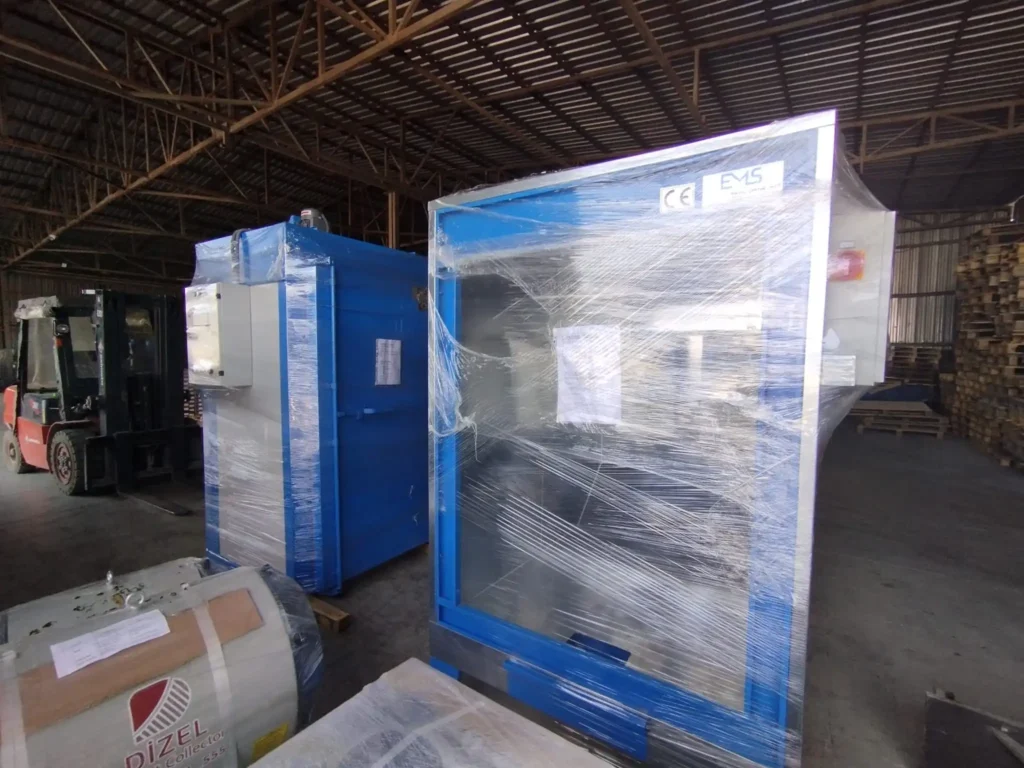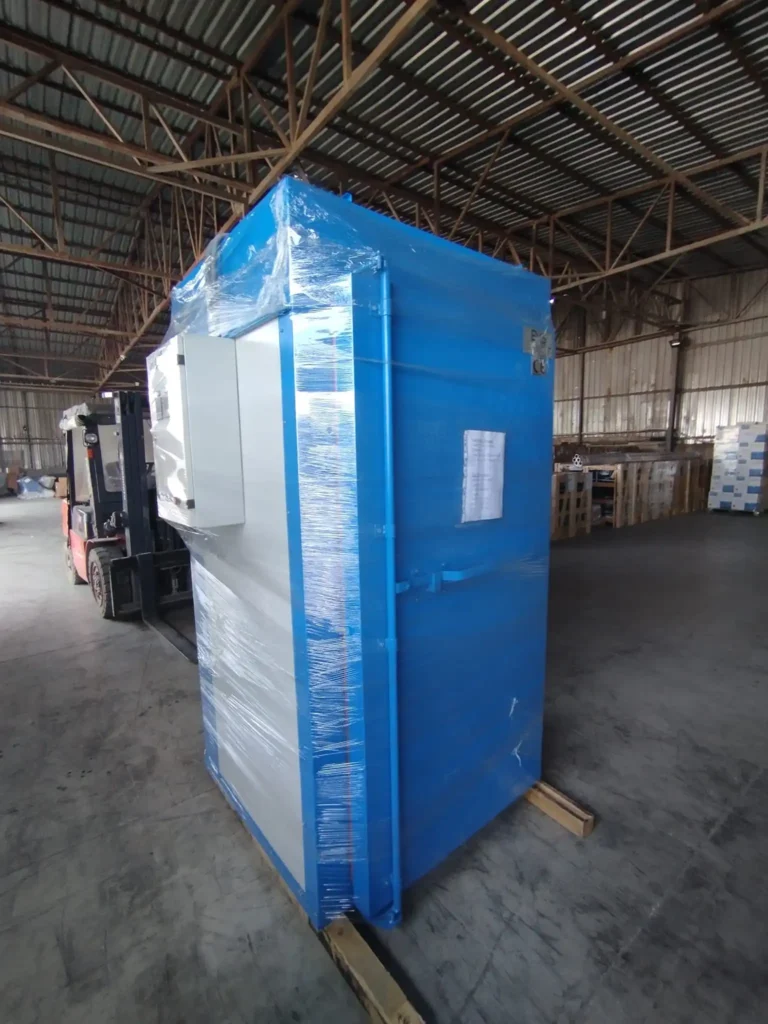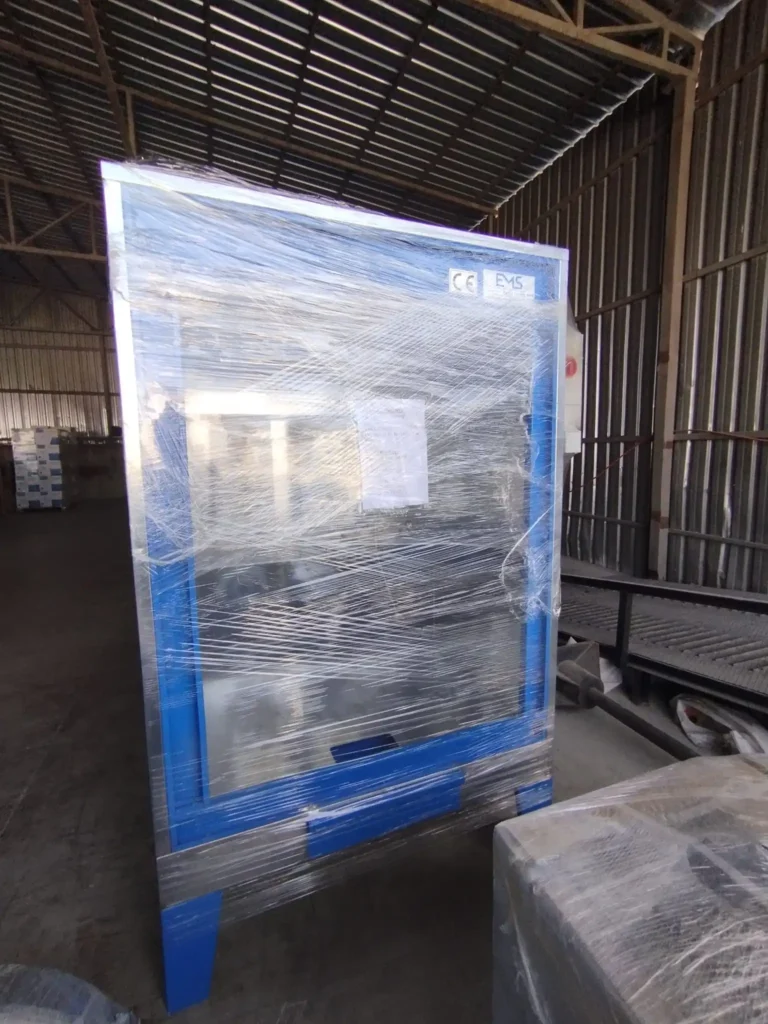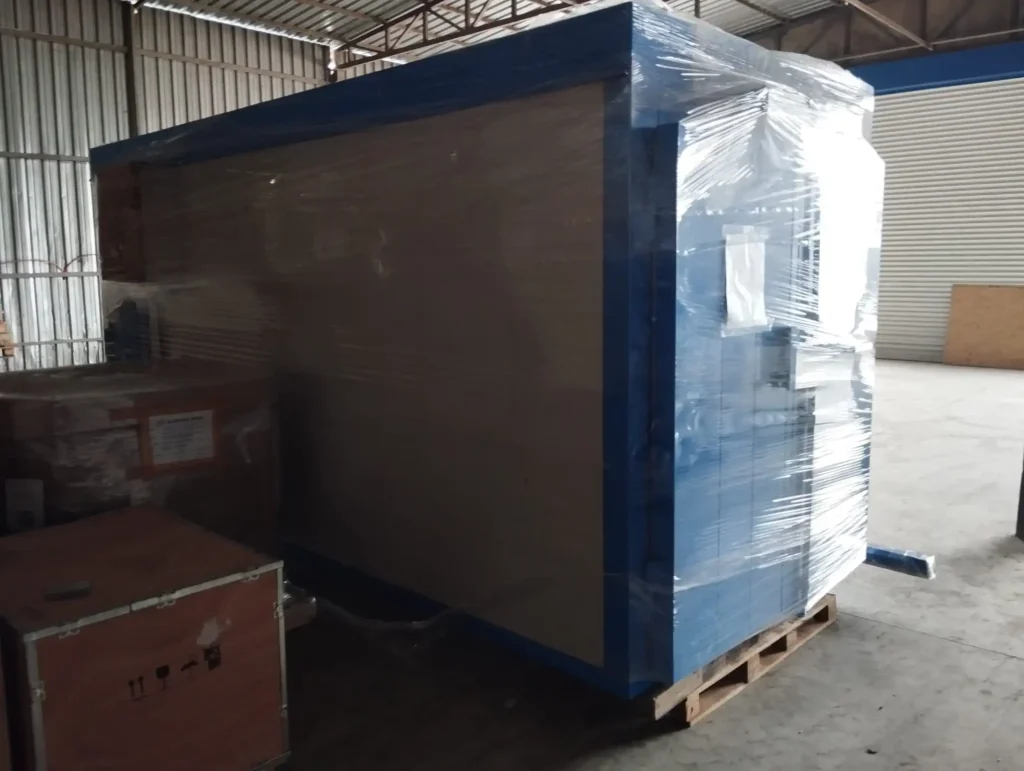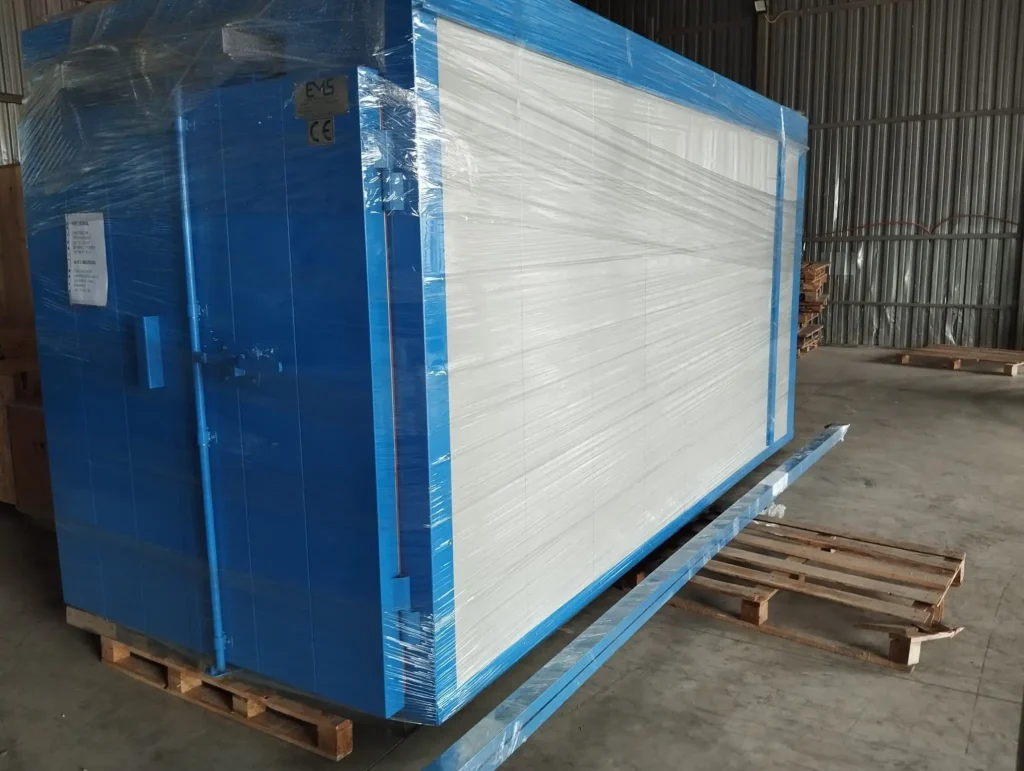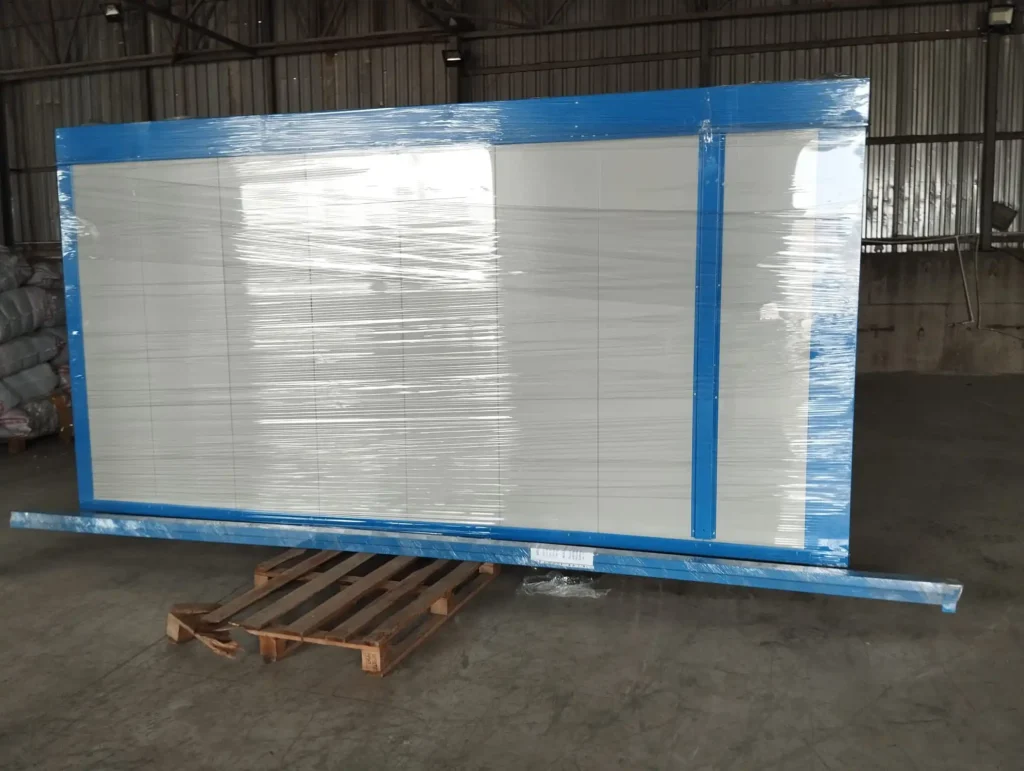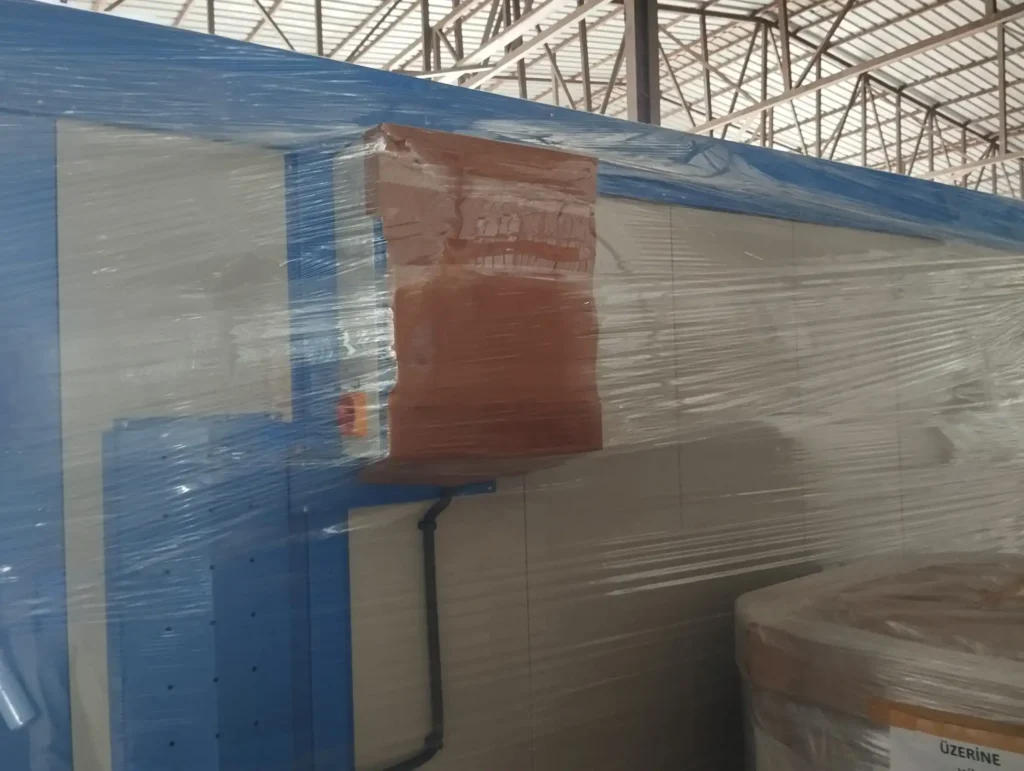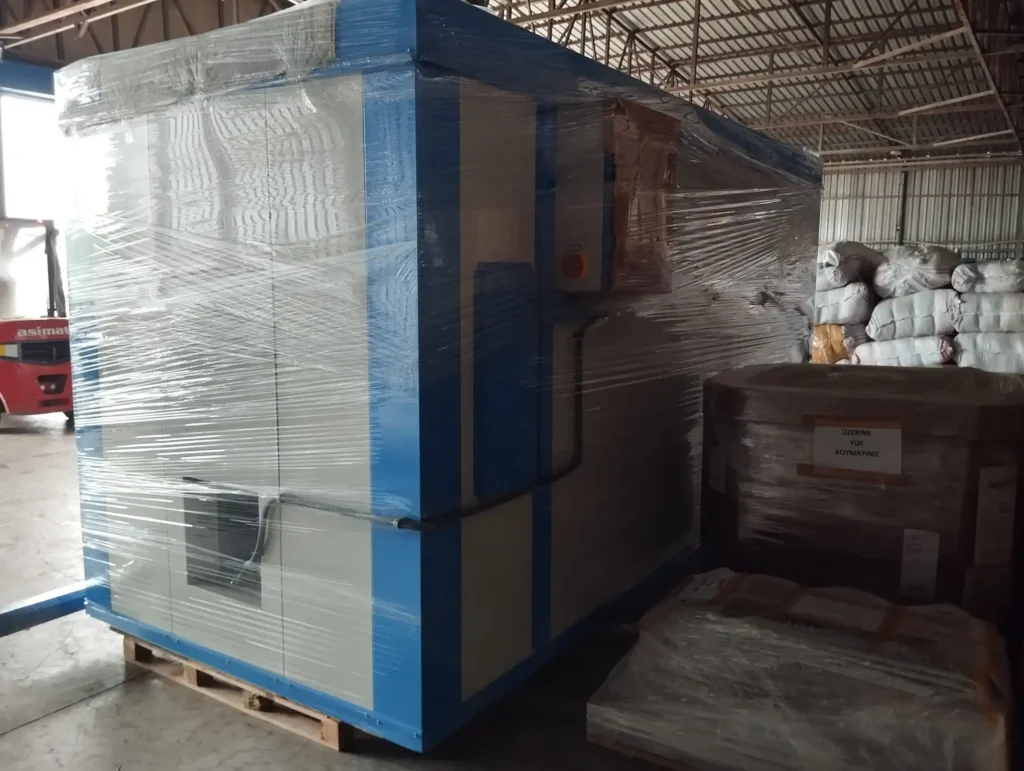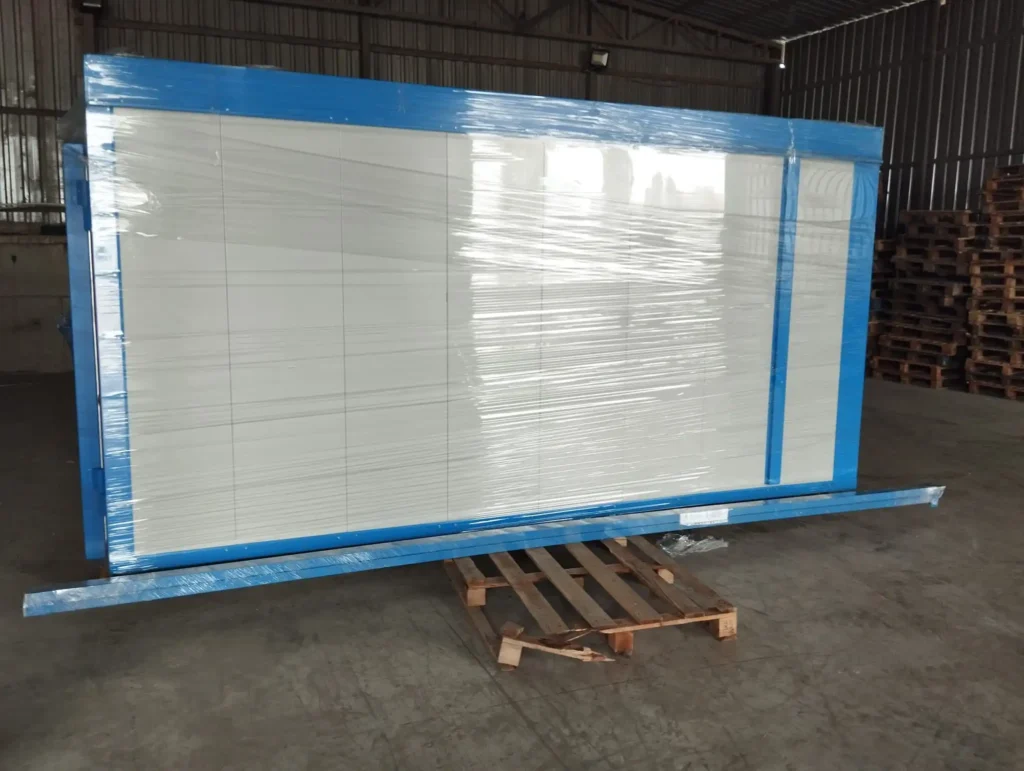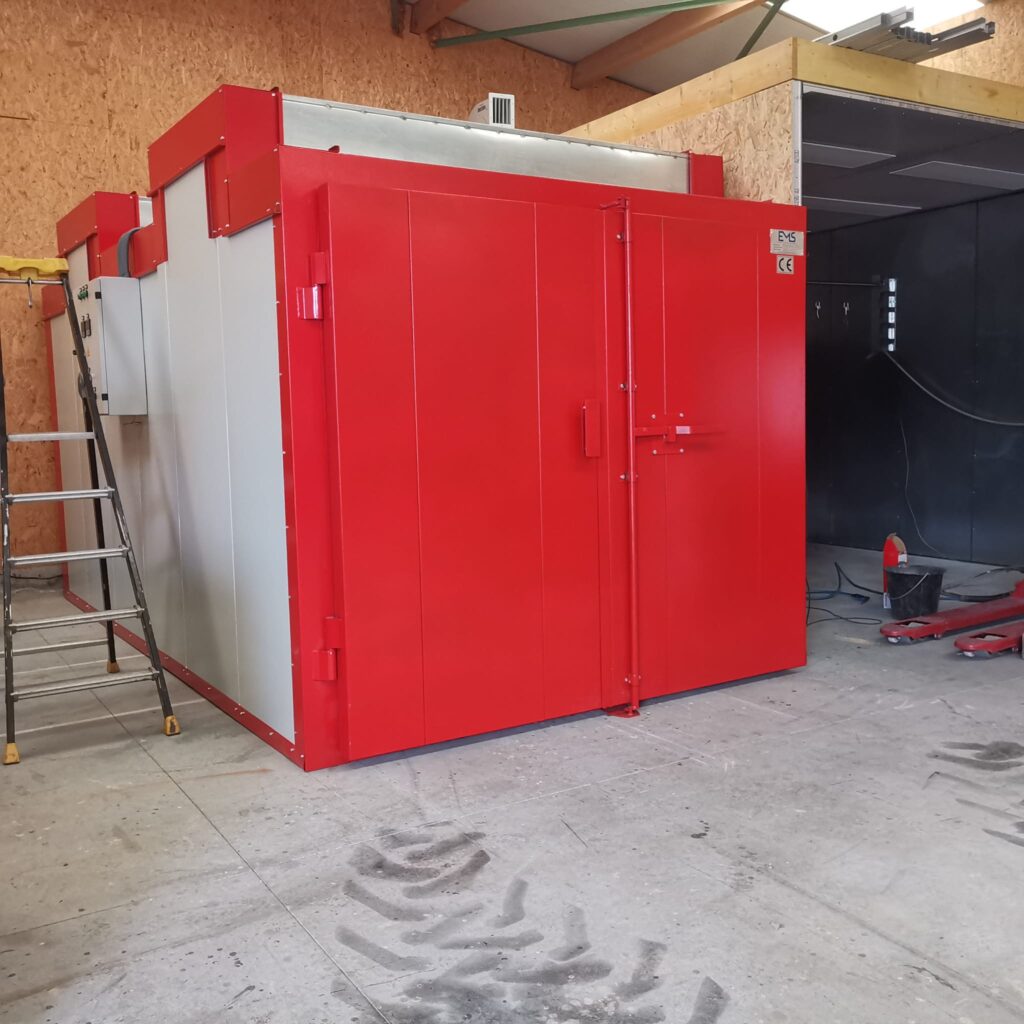
Powder Coat Oven Canada: Powder coating technology represents a significant evolution in the field of industrial coating processes. Unlike traditional liquid coatings, which rely on solvent-based applications, powder coating uses finely ground particles of resin and pigment, electrostatically charged and sprayed onto a surface. The result is a uniform, high-quality finish that offers enhanced durability, corrosion resistance, and aesthetic appeal.
Powder coating has gained widespread acceptance across various industries, including automotive, aerospace, appliances, and architecture, due to its environmentally friendly properties. The absence of harmful volatile organic compounds (VOCs) makes powder coating a preferred choice for companies seeking sustainable manufacturing practices. Additionally, the efficient application process ensures minimal waste, as any overspray can be collected and reused.
At its core, powder coating technology involves four key stages:
- Surface Preparation – Cleaning and treating the surface to ensure proper adhesion of the powder.
- Powder Application – Electrostatically applying the powder particles to the surface.
- Curing Process – Heating the coated object in an oven to fuse the powder into a smooth, durable layer.
- Final Inspection – Quality control measures to ensure the coating meets industry standards.
Each of these steps is supported by specialized equipment designed to enhance precision, consistency, and efficiency. In the following sections, we will delve into the specifics of the equipment, tools, and systems essential for a high-quality powder coating operation.
Powder Coating Equipment
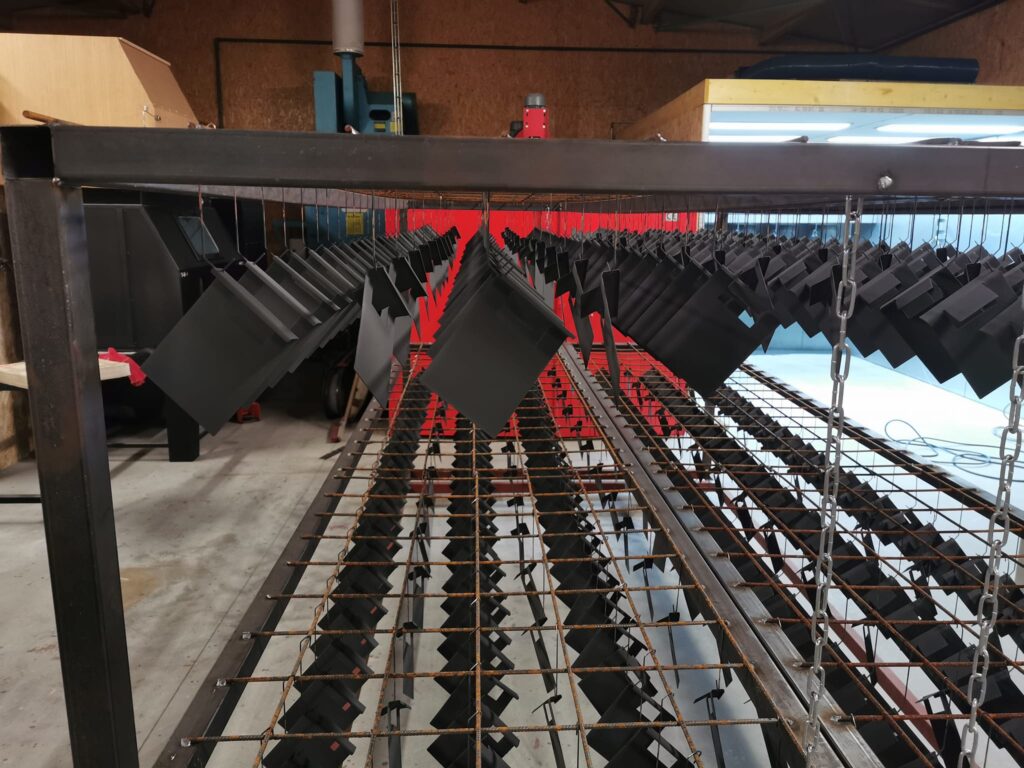
Powder coating equipment encompasses a broad range of machines and tools that facilitate the efficient and high-quality application of powder coatings across industries. Whether for large industrial operations or smaller businesses, the right equipment is essential for achieving consistent, high-quality results.
The essential components of a typical powder coating system include:
- Powder Spray Guns – These guns are responsible for electrostatically charging and applying powder to the workpiece.
- Powder Coating Booths – Enclosures designed to contain the powder during application and ensure a clean, controlled environment.
- Curing Ovens – Specialized ovens used to bake and cure the powder, creating a durable, finished surface.
- Recovery Systems – Systems that collect and recycle excess powder to minimize waste and increase cost-efficiency.
Advanced powder coating equipment also includes automated conveyor systems, designed to move parts through each stage of the process seamlessly. For larger industries, automation significantly increases production speed while maintaining consistency and reducing labor costs. Key considerations when selecting powder coating equipment include:
- Production Capacity – The volume of parts that need to be coated.
- Energy Efficiency – Choosing energy-efficient curing ovens and recovery systems can greatly reduce operating costs.
- Customization Options – The ability to adjust settings for different types of powder and workpieces ensures versatility in operations.
Selecting the right equipment is critical to maintaining a balance between cost, efficiency, and product quality. The following section will discuss paint spray and coating systems, which play a complementary role in powder coating operations.
Paint Spray and Coatings Systems
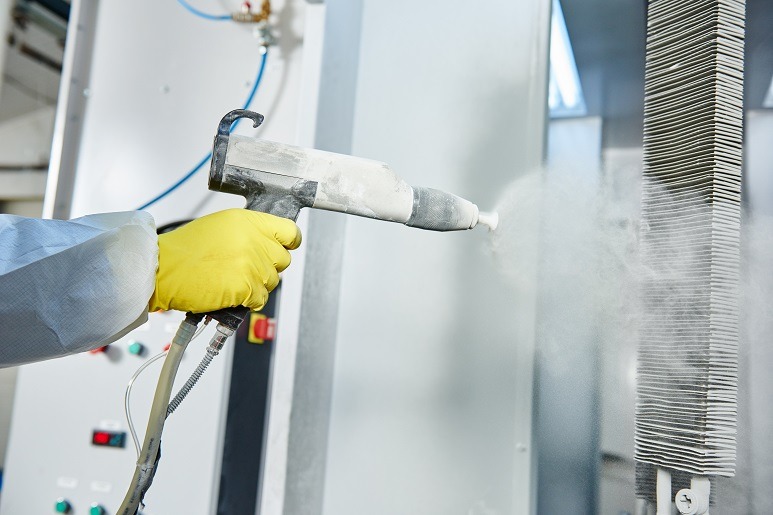
In the realm of industrial coatings, paint spray and coatings systems are integral components for achieving uniform and high-quality finishes. While powder coating has gained prominence for its eco-friendly and durable nature, traditional paint spray systems remain widely used in various industries for liquid coatings. The interplay between paint spray systems and powder coating technologies offers manufacturers the flexibility to choose the most suitable method depending on the material, surface, and application requirements.
Types of Paint Spray Systems
- Air Spray Systems
Air spray systems use compressed air to atomize liquid paint and apply it to the surface. These systems are known for their ability to achieve a smooth and fine finish, making them ideal for applications where surface aesthetics are critical, such as in automotive or consumer goods. However, they tend to produce higher levels of overspray compared to other systems, resulting in material waste and potential environmental concerns. - Airless Spray Systems
Airless spray systems, as the name suggests, do not rely on compressed air. Instead, high-pressure pumps force the coating material through a small orifice, creating a fine mist. Airless systems are often preferred for high-volume applications, such as coating large industrial structures or heavy machinery. They provide excellent coverage and minimize overspray, making them more efficient for large-scale projects. - Electrostatic Spray Systems
Similar to powder coating, electrostatic spray systems charge the paint particles, causing them to adhere more uniformly to the surface. This method significantly reduces overspray and waste while ensuring even coverage, especially on irregular or complex surfaces. Electrostatic systems are often used in combination with powder coating processes in industries that demand both liquid and powder finishes.
Compatibility with Powder Coating Systems
While liquid coatings and powder coatings have different application methods, they are often used together in manufacturing processes to provide complementary benefits. For example, certain substrates may require a liquid primer for better adhesion, followed by a powder topcoat for enhanced durability and environmental protection.
Paint spray systems, especially those using electrostatic principles, offer manufacturers the flexibility to switch between powder and liquid applications as needed. This capability is particularly valuable in industries such as automotive manufacturing, where certain components may require different types of coatings depending on their function and exposure to environmental factors.
Powder Coating Installation

The installation of a powder coating system is a complex process that requires careful planning, precise equipment selection, and seamless integration into the existing production workflow. Whether for small businesses or large-scale industrial facilities, installing a powder coating line involves numerous steps to ensure efficiency, safety, and high-quality results.
Key Considerations for Powder Coating Installation
- Facility Layout and Space Requirements
Before selecting equipment, it is essential to evaluate the available space in the facility. Powder coating booths, curing ovens, and conveyor systems all require sufficient space for proper operation. Additionally, the layout should accommodate the workflow, ensuring that parts move smoothly through surface preparation, coating, curing, and final inspection stages without bottlenecks. - Electrical and Ventilation Requirements
Powder coating systems, particularly curing ovens, require significant electrical power. Ensuring that the facility’s electrical system can support the equipment is critical to preventing power shortages or system failures. Additionally, proper ventilation is necessary to maintain air quality, prevent contamination, and protect workers from exposure to particulate matter and fumes generated during the coating process. - Equipment Selection and Integration
Selecting the right powder coating equipment depends on production volume, material types, and finish quality requirements. For large-scale installations, automated conveyor systems can significantly improve efficiency by moving parts through the coating and curing stages without manual intervention. Smaller operations may opt for manual or semi-automated systems, which offer more flexibility for coating different parts or materials. - Compliance with Environmental Regulations
One of the key advantages of powder coating is its minimal environmental impact, thanks to the absence of VOCs and hazardous solvents. However, the installation of a powder coating system must still comply with local environmental regulations, particularly regarding air emissions, waste management, and worker safety. Ensuring that the powder coating booth has proper filtration and recovery systems in place is critical to meeting these regulatory requirements. - Maintenance and Support Infrastructure
Once the powder coating installation is complete, ongoing maintenance is crucial to ensure that the system continues to operate at peak efficiency. This includes regular cleaning of spray guns and booths, checking the performance of heating elements in the curing ovens, and monitoring the electrical systems. Having access to reliable technical support and spare parts can reduce downtime and prolong the life of the equipment.
Mini Lab Oven
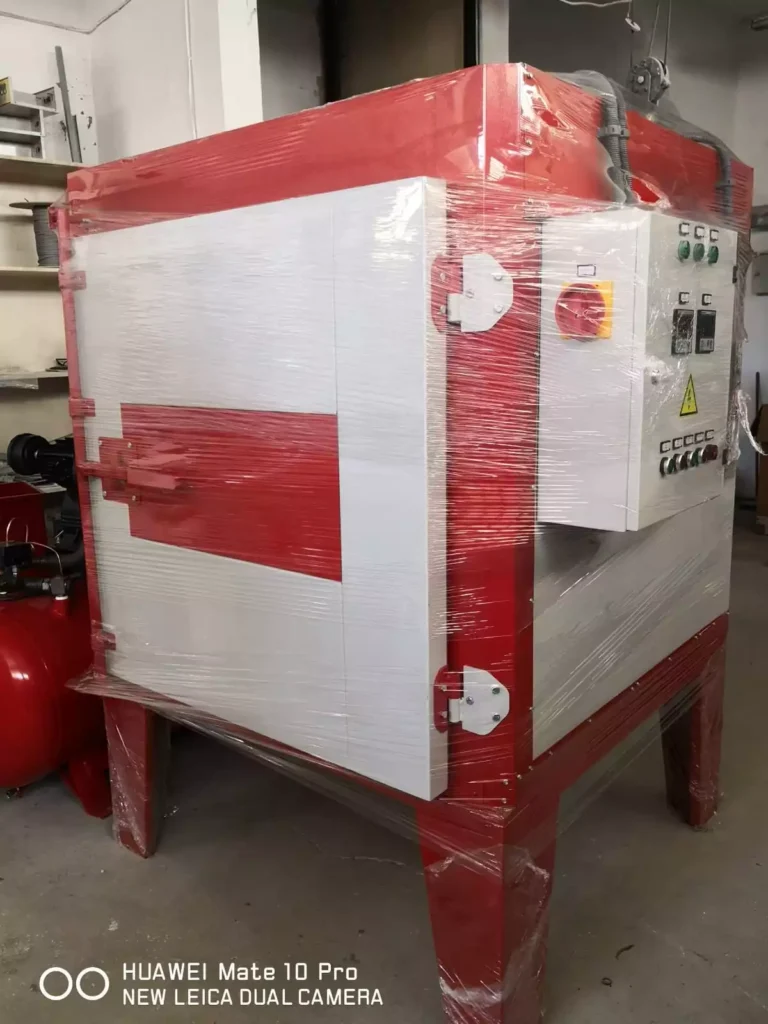
A mini lab oven is a compact and highly specialized piece of equipment used in small-scale powder coating applications, quality control testing, and product development environments. These ovens play a crucial role in helping businesses refine their coating processes by providing precise control over curing temperatures and times.
Applications of Mini Lab Ovens
- Quality Control Testing
In industries where the quality of the powder coating finish is paramount, such as automotive or aerospace manufacturing, mini lab ovens allow engineers and technicians to perform rapid testing on small samples. This ensures that the coating meets the required standards for adhesion, thickness, and durability before moving on to full-scale production. - Small Batch Production
For businesses that produce limited quantities of powder-coated products or prototypes, mini lab ovens offer a cost-effective and space-efficient solution. These ovens allow small parts or components to be coated and cured without the need for a large-scale oven, reducing operational costs. - Product Development and Research
In R&D settings, mini lab ovens enable companies to experiment with different powder formulations and curing cycles. This flexibility is essential for developing new products or refining existing coatings to meet specific performance requirements, such as increased corrosion resistance or improved UV stability.
Technical Specifications of Mini Lab Ovens
Mini lab ovens come in a variety of sizes and configurations, depending on the specific needs of the user. Common features include:
- Temperature Control: Precise control over curing temperatures is essential to ensure that the powder properly adheres and forms a durable finish.
- Uniform Heating: Mini lab ovens are designed to ensure uniform heat distribution throughout the chamber, preventing uneven curing or defects in the coating.
- Compact Design: These ovens are typically much smaller than industrial curing ovens, making them ideal for use in labs or small production environments.
- Energy Efficiency: Many modern mini lab ovens are designed with energy efficiency in mind, reducing operating costs while still providing the necessary heat for powder curing.
Wheel Powder Coating Equipment

Powder coating wheels has become increasingly popular, particularly in the automotive aftermarket, where both aesthetic customization and durability are paramount. Wheel powder coating equipment is specifically designed to handle the unique challenges of coating wheel rims and other automotive components, providing a high-quality, long-lasting finish.
Why Powder Coating for Wheels?
Powder coating offers several distinct advantages over traditional paint for wheel finishes:
- Durability: Powder coating is known for its resistance to chips, scratches, and corrosion, making it ideal for parts that are exposed to harsh road conditions.
- Aesthetic Variety: With powder coating, wheels can be finished in a wide range of colors and textures, allowing for customization that is difficult to achieve with traditional liquid paints.
- Environmentally Friendly: Powder coating produces no VOCs, making it a more environmentally responsible choice for both manufacturers and consumers.
Types of Wheel Powder Coating Equipment
- Automated Powder Coating Systems
For high-volume wheel manufacturers or refurbishment businesses, automated powder coating systems provide consistent results with minimal manual intervention. These systems typically include automated spray guns and conveyor systems that move wheels through the coating and curing processes seamlessly. - Manual Powder Coating Systems
Smaller businesses or those focusing on custom wheel finishes may opt for manual powder coating systems. These systems allow for more flexibility in terms of color changes and customization, though they require skilled operators to ensure even coverage and a high-quality finish. - Wheel-Specific Fixtures
One of the key components of wheel powder coating equipment is the specialized fixtures used to hold the wheels during the coating process. These fixtures are designed to allow for full coverage without obstructing any part of the wheel, ensuring a smooth and even finish.
Curing Ovens for Wheels
The curing process is critical for ensuring that the powder adheres properly to the wheel and forms a durable coating. Wheel powder coating ovens are designed to accommodate the unique shape and size of wheels, providing uniform heat distribution to prevent any defects in the finish. These ovens typically operate at temperatures between 350°F and 400°F, depending on the type of powder being used.
Small Batch Powder Coating
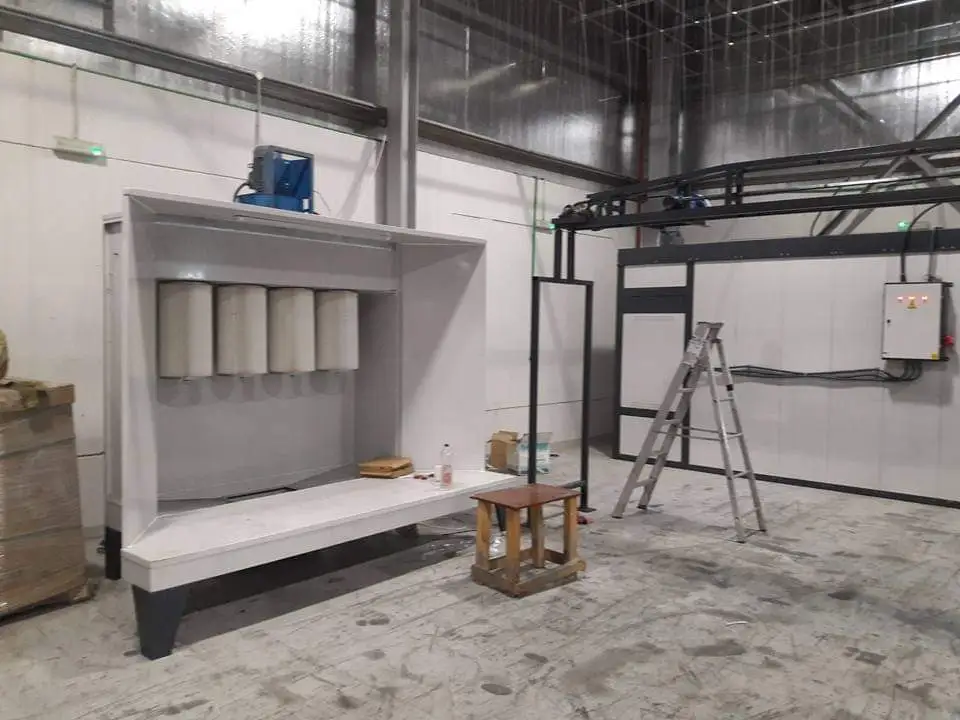
Small batch powder coating is an ideal solution for businesses that do not require high-volume production or for companies that specialize in custom, low-quantity orders. Unlike large-scale powder coating operations, small batch systems offer more flexibility in terms of color changes, part sizes, and customization.
Advantages of Small Batch Powder Coating
- Cost-Effective for Low Volume Production
For manufacturers who produce limited quantities of products, small batch powder coating provides a more cost-effective alternative to large-scale automated systems. Small batch operations typically require less space, less energy, and fewer resources, resulting in lower overall costs. - Flexibility in Color Changes
One of the major benefits of small batch powder coating is the ability to quickly switch between different colors or types of powder. This is particularly useful for businesses that offer custom powder coating services or for manufacturers who need to coat different parts in different finishes. - Faster Turnaround Times
Because small batch powder coating systems are more flexible, they can often achieve faster turnaround times compared to larger systems. This is especially beneficial for companies that need to quickly fulfill custom orders or meet tight production deadlines. - Reduced Waste
Small batch powder coating systems typically produce less waste compared to large-scale operations. This is due in part to the more efficient use of powder, as well as the ability to recover and reuse excess powder. This not only helps reduce costs but also minimizes the environmental impact of the coating process.
Equipment for Small Batch Powder Coating
Small batch powder coating systems generally consist of:
- Manual or Semi-Automatic Spray Guns: These allow for more control and precision when applying the powder, which is essential for achieving a high-quality finish on small or custom parts.
- Small-Scale Powder Booths: Compact powder coating booths are designed for smaller operations, providing the necessary containment and filtration to ensure a clean and safe working environment.
- Curing Ovens: Small batch ovens are typically more compact and energy-efficient, making them ideal for businesses that do not require large-scale production.
Industrial Spray Coating System

Industrial spray coating systems are designed for high-volume operations where speed, efficiency, and precision are critical. These systems are commonly used in industries such as automotive, aerospace, heavy machinery, and electronics, where large quantities of parts need to be coated consistently and quickly. Industrial spray systems are known for their ability to handle a wide variety of coatings, including both liquid and powder, depending on the requirements of the application.
Types of Industrial Spray Coating Systems
- Conveyorized Spray Systems
Conveyorized systems are fully automated and are designed for large-scale production lines. These systems are capable of moving parts through multiple stages of the coating process, including pre-treatment, coating, and curing, without the need for manual intervention. Conveyorized spray systems are ideal for industries that require high throughput and consistent coating quality. The automation in these systems reduces the risk of human error and increases overall production efficiency. - Batch Spray Systems
Batch spray systems are typically used for smaller-scale operations or when a high level of customization is required. Unlike conveyorized systems, batch systems allow operators to manually load and unload parts, making them more flexible for businesses that deal with a variety of different products. These systems are often paired with manual or semi-automated spray guns, allowing for greater control over the coating process. - Robotic Spray Systems
In highly automated industrial environments, robotic spray systems are becoming increasingly common. These systems use programmed robots to apply coatings with a high degree of precision, ensuring even coverage on complex or irregularly shaped parts. Robotic systems are particularly useful for applications where consistency and repeatability are critical, such as in automotive manufacturing.
Benefits of Industrial Spray Coating Systems
- High Production Rates: Industrial spray systems are designed to handle large volumes of parts, making them ideal for industries with high production demands.
- Consistency and Precision: Automated and robotic systems ensure that each part receives a uniform coating, reducing the likelihood of defects or variations.
- Efficiency: By automating the coating process, industrial spray systems reduce the amount of labor required and improve the overall efficiency of the production line.
- Versatility: These systems can be used with a variety of coatings, including liquid, powder, and specialty coatings, depending on the specific needs of the industry.
Powdercoating Tools

Powdercoating tools are essential for achieving a high-quality finish and ensuring that the powder coating process runs smoothly. From surface preparation to the final application of the powder, a wide range of tools is used to improve the efficiency, precision, and safety of the coating process.
Key Powdercoating Tools
- Powder Coating Spray Guns
The spray gun is the most critical tool in the powder coating process. It is responsible for applying the powder evenly to the surface of the workpiece. Modern powder coating spray guns use electrostatic technology to charge the powder particles, which helps them adhere to the surface. There are several types of spray guns, including manual and automatic models, each suited to different production environments. - Surface Preparation Tools
Proper surface preparation is essential for ensuring that the powder adheres correctly and forms a durable bond with the substrate. Surface preparation tools include sandblasters, grinders, and chemical cleaners. These tools are used to remove dirt, rust, and other contaminants from the surface before the powder is applied. - Masking Tools
Masking is used to protect certain areas of a part from being coated. Specialized masking tools, such as high-temperature tapes, silicone plugs, and caps, are used to block off areas that should remain uncoated during the powder application process. These tools ensure precision, especially in parts with complex geometries. - Powder Recovery Systems
To reduce waste and improve cost efficiency, many powder coating systems are equipped with powder recovery systems. These systems capture and recycle overspray, allowing the excess powder to be reused in future applications. Tools like cartridge filters, cyclones, and hoppers are integral components of the recovery process. - Curing Lamps and Ovens
Curing tools are necessary to properly heat the coated parts and allow the powder to flow and bond to the substrate. For smaller operations, infrared curing lamps are often used as a portable and cost-effective option. For larger-scale production, curing ovens are necessary to handle bigger parts or larger volumes of coated items.
Importance of Maintenance and Calibration
Regular maintenance and calibration of powdercoating tools are crucial for achieving consistent results. Spray guns must be cleaned and calibrated frequently to ensure that the powder is applied evenly. Similarly, recovery systems and curing ovens require regular inspections to maintain their efficiency and performance.
Powder Paint Gun
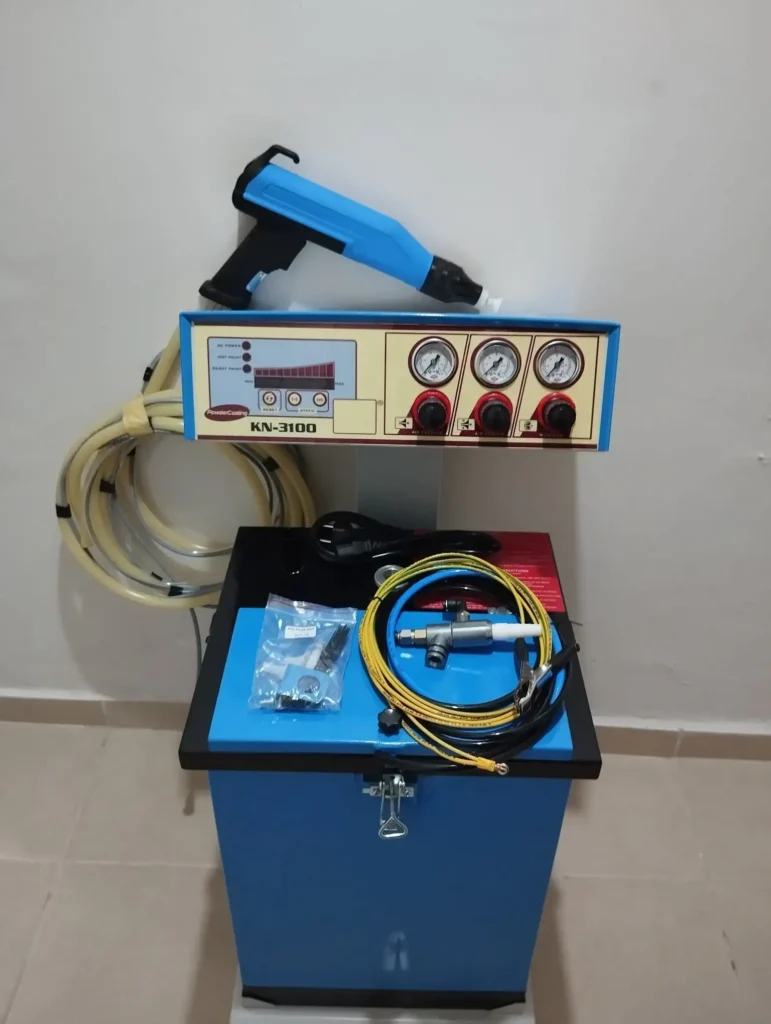
The powder paint gun is a key component in the powder coating process, responsible for applying the powder evenly onto a substrate. Powder paint guns use electrostatic energy to charge the powder particles, which are then attracted to the grounded workpiece. This electrostatic attraction ensures an even coat and minimizes waste during the application process.
Types of Powder Paint Guns
- Manual Powder Paint Guns
Manual powder paint guns are used in smaller or more customized applications where flexibility is required. These guns are operated by skilled technicians who manually control the application of the powder. Manual guns offer more precision and control, making them ideal for coating parts with intricate designs or hard-to-reach areas. - Automatic Powder Paint Guns
Automatic powder paint guns are used in large-scale industrial applications where high production speeds and consistent results are critical. These guns are typically integrated into automated systems, where they apply powder to parts moving along a conveyor system. Automatic guns reduce the need for manual labor and can operate at much higher speeds than manual guns.
Key Features of Powder Paint Guns
- Electrostatic Charging: The core technology behind powder paint guns is electrostatic charging, which ensures that the powder particles are attracted to the workpiece and adhere evenly. This process also minimizes overspray and waste, making the coating process more efficient.
- Adjustable Flow Rates: Many powder paint guns allow users to adjust the flow rate of the powder, giving operators control over the thickness of the coating. This feature is essential for applications that require different coating thicknesses for different parts or materials.
- Interchangeable Nozzles: To accommodate different part sizes and shapes, powder paint guns often come with interchangeable nozzles. These nozzles allow operators to adjust the spray pattern, ensuring complete coverage of the workpiece.
Choosing the Right Powder Paint Gun
When selecting a powder paint gun, businesses must consider factors such as production volume, part complexity, and coating requirements. For small operations or custom projects, manual guns may be the best option, offering flexibility and control. For larger production lines, automatic guns are more efficient and can significantly increase throughput while maintaining consistent quality.
Powder Coating Paint Gun
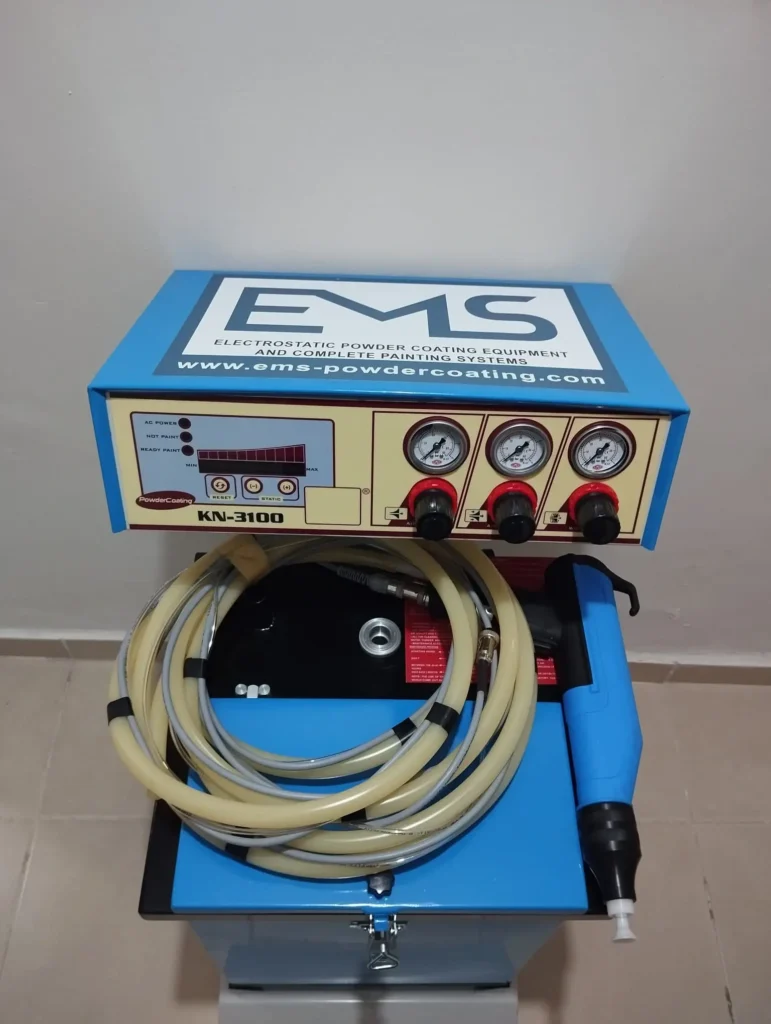
A powder coating paint gun is specifically designed for the application of powder coatings, which differ from liquid paints in both composition and application techniques. The powder coating process involves electrostatically charging powdered particles and spraying them onto a substrate, where they adhere and form a durable finish after curing. The powder coating paint gun is the tool that facilitates this application, ensuring even coverage and efficiency.
Components of a Powder Coating Paint Gun
- Electrostatic Charging Unit
The charging unit is the heart of the powder coating paint gun. This component generates the electrostatic charge that helps powder particles adhere to the workpiece. Powder particles become positively or negatively charged as they pass through the gun, and they are attracted to the grounded substrate. - Powder Hopper and Pump
The hopper stores the powder and feeds it into the gun. The pump controls the flow of powder, ensuring a steady and controlled delivery to the spray nozzle. The design and capacity of the hopper and pump vary depending on the application and the volume of powder being applied. - Spray Nozzle
The spray nozzle controls the pattern and density of the powder being sprayed. Different nozzles are available to suit different applications, from wide, even sprays for large, flat surfaces to more concentrated sprays for intricate or hard-to-reach areas. The nozzle must be selected carefully based on the type of part being coated and the required finish. - Grounding System
The grounding system is critical to the powder coating process. Without proper grounding, the electrostatic charge will not work effectively, and the powder will not adhere uniformly. Powder coating guns are designed to ensure that the workpiece is properly grounded, reducing the risk of uneven coverage or defects in the finish.
Advantages of Powder Coating Paint Guns
- Even Application: The electrostatic process ensures that powder particles are evenly distributed across the surface of the workpiece, resulting in a smooth and consistent finish.
- Reduced Waste: Powder coating paint guns are designed to minimize overspray, reducing the amount of wasted powder and improving overall efficiency.
- Flexibility: Powder coating paint guns can be used on a wide variety of substrates, including metal, glass, and plastic. They are also suitable for both small-scale custom jobs and large-scale industrial applications.
Maintenance of Powder Coating Paint Guns
Regular maintenance is essential to keep powder coating paint guns operating at peak performance. This includes cleaning the spray nozzles to prevent clogging, checking the electrostatic charging unit for proper functionality, and ensuring that the grounding system is working correctly. Proper maintenance not only extends the life of the equipment but also ensures consistent, high-quality results.
Professional Powder Coating Gun
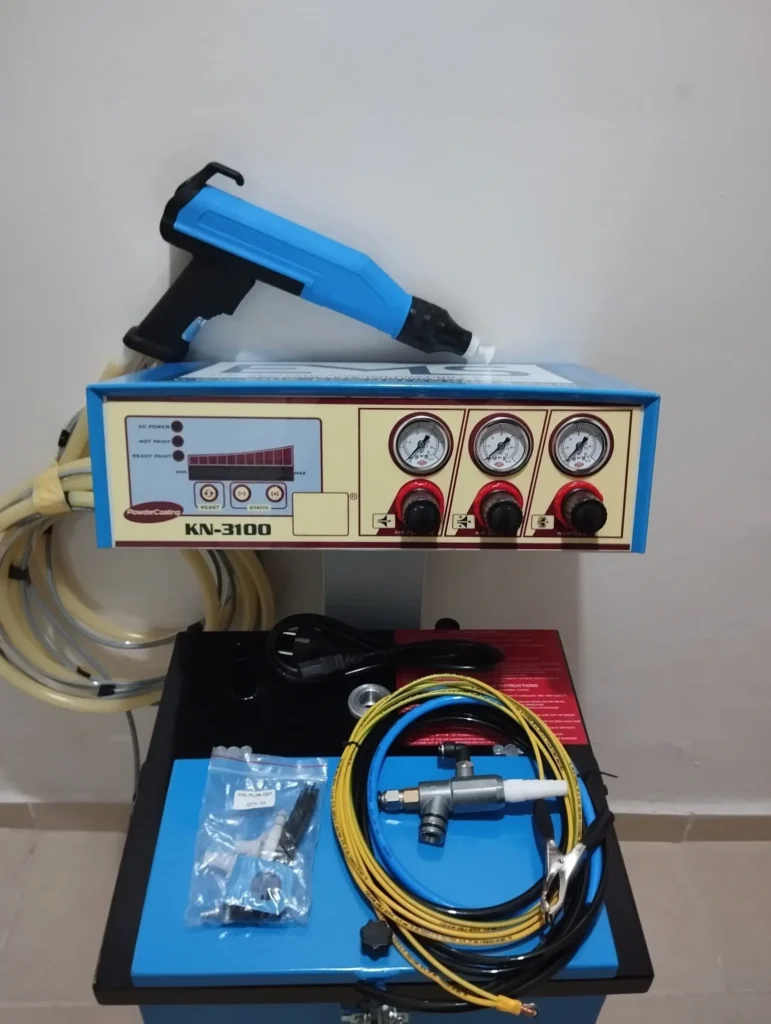
A professional powder coating gun is a high-performance tool designed for industrial-grade powder coating applications. These guns are built to handle large-scale production environments, where durability, precision, and efficiency are critical. Professional powder coating guns are often equipped with advanced features that allow operators to fine-tune the application process, ensuring optimal results even in the most demanding conditions.
Key Features of Professional Powder Coating Guns
- High Output Capability
Professional powder coating guns are designed to handle high volumes of powder, making them suitable for large-scale industrial operations. These guns can deliver consistent coverage at high speeds, reducing production time and increasing throughput. - Precision Control
Advanced professional powder coating guns come with features that allow operators to adjust the spray pattern, powder flow rate, and electrostatic charge. These controls provide a high degree of precision, ensuring that the coating is applied evenly, regardless of the complexity of the part being coated. - Durability and Reliability
In industrial environments, powder coating guns are subjected to heavy use. Professional-grade guns are built with durable materials and components that can withstand the rigors of continuous operation. These guns are also designed for easy maintenance, with replaceable parts that can be swapped out as needed to keep the equipment running smoothly. - Compatibility with Automation
Many professional powder coating guns are designed to be compatible with automated systems, such as conveyorized or robotic powder coating lines. This allows businesses to integrate the guns into fully automated production environments, increasing efficiency and reducing the need for manual intervention.
Applications of Professional Powder Coating Guns
Professional powder coating guns are used in a wide range of industries, including:
- Automotive: Coating car bodies, wheels, and other metal components with durable finishes that resist corrosion and wear.
- Aerospace: Applying protective coatings to aircraft components, ensuring they can withstand harsh environmental conditions.
- Furniture: Coating metal furniture parts with colorful, durable finishes that enhance both appearance and longevity.
- Electronics: Providing protective coatings for metal enclosures and components used in electronic devices, preventing corrosion and electrical interference.
Manual Powder Coating Machine

A manual powder coating machine is designed for businesses or operations that need flexibility, precision, and control in the powder coating process. Unlike automated systems, manual powder coating machines rely on human operators to handle the application of the powder, making them suitable for custom or small-batch projects.
Advantages of Manual Powder Coating Machines
- Flexibility in Operations
Manual powder coating machines allow operators to adjust settings and techniques to suit different parts and surfaces. This flexibility is particularly valuable in small-scale or custom jobs where each part may require a slightly different application process. For example, small or intricately designed parts may need more careful attention during the coating process, which is easily managed using a manual machine. - Cost-Effective for Small Productions
Small businesses or companies that specialize in limited production runs can benefit from manual powder coating machines due to their lower cost compared to fully automated systems. Manual machines do not require the same level of infrastructure, such as conveyor belts or robotics, making them more affordable and accessible for businesses with lower production volumes. - Precision and Customization
Skilled operators can control the spray pattern, powder flow, and application technique to ensure the coating is applied precisely. This is especially useful when working with complex or custom parts that require detailed attention. Manual powder coating machines are often used in industries that require highly customized finishes, such as automotive customizations or artistic metalwork.
Key Components of a Manual Powder Coating Machine
- Spray Gun: The operator uses a manual powder coating spray gun to apply the powder. The spray gun contains an electrostatic charging mechanism, ensuring that the powder adheres to the workpiece evenly.
- Control Unit: The control unit allows operators to adjust the voltage, powder flow rate, and air pressure, providing control over how the powder is applied. This unit is critical in ensuring the flexibility and precision of manual operations.
- Powder Hopper: The powder hopper stores the powder and feeds it into the spray gun. It is an essential part of the machine, ensuring that the correct amount of powder is delivered during the coating process.
- Grounding System: Proper grounding is essential to ensure that the powder adheres to the surface of the workpiece. Manual machines come with grounding clamps or systems that ensure safety and coating efficiency.
Applications of Manual Powder Coating Machines
Manual powder coating machines are commonly used in:
- Custom Automotive Coatings: Offering customized finishes for car parts, such as wheels or chassis components.
- Small-Scale Manufacturing: Ideal for small production runs where automation would not be cost-effective.
- Prototyping and Product Development: Useful in R&D settings where new powder formulations or coating processes are being tested.
Used Powder Coating Oven

Used powder coating ovens are a popular choice for businesses looking to expand their production capabilities while minimizing costs. These ovens are a critical part of the powder coating process, providing the heat needed to cure the powder and create a durable finish. While purchasing a brand-new oven can be expensive, used ovens offer a more budget-friendly alternative.
Advantages of Purchasing a Used Powder Coating Oven
- Cost Savings
The primary reason businesses choose to buy used powder coating ovens is the significant cost savings. Used ovens can often be purchased at a fraction of the price of a new one, making them an attractive option for smaller businesses or those just starting out in the powder coating industry. - Faster Availability
New powder coating ovens often have long lead times due to manufacturing and customization requirements. By purchasing a used oven, businesses can have the equipment installed and operational much faster, helping them meet production deadlines more efficiently. - Proven Reliability
Many used powder coating ovens have been in operation for years, proving their reliability and durability. As long as the oven has been well-maintained, it can continue to deliver high-quality results for many years after its initial use.
Considerations When Buying a Used Powder Coating Oven
- Condition and Maintenance History
It is essential to thoroughly inspect the condition of the used oven before purchasing. Ask for maintenance records and check for any signs of wear or damage, such as malfunctioning heating elements, broken seals, or uneven temperature distribution. A well-maintained oven is more likely to provide consistent performance over the long term. - Energy Efficiency
Older ovens may not be as energy-efficient as newer models. Businesses should consider the long-term operating costs of a used oven, particularly if it consumes more energy than a newer, more efficient model. Investing in a used oven that is energy-efficient can still offer significant savings over time. - Size and Capacity
Ensure that the used oven is appropriately sized for the business’s production needs. Too small an oven will limit productivity, while an overly large oven can result in unnecessary energy consumption. Consider the types of parts or products that will be coated and choose an oven with sufficient capacity to handle them. - Warranty and Support
Many used equipment dealers offer limited warranties or support packages. Be sure to inquire about any warranties that come with the used oven and whether the dealer provides installation, maintenance, or repair services.
Powder Coat Oven
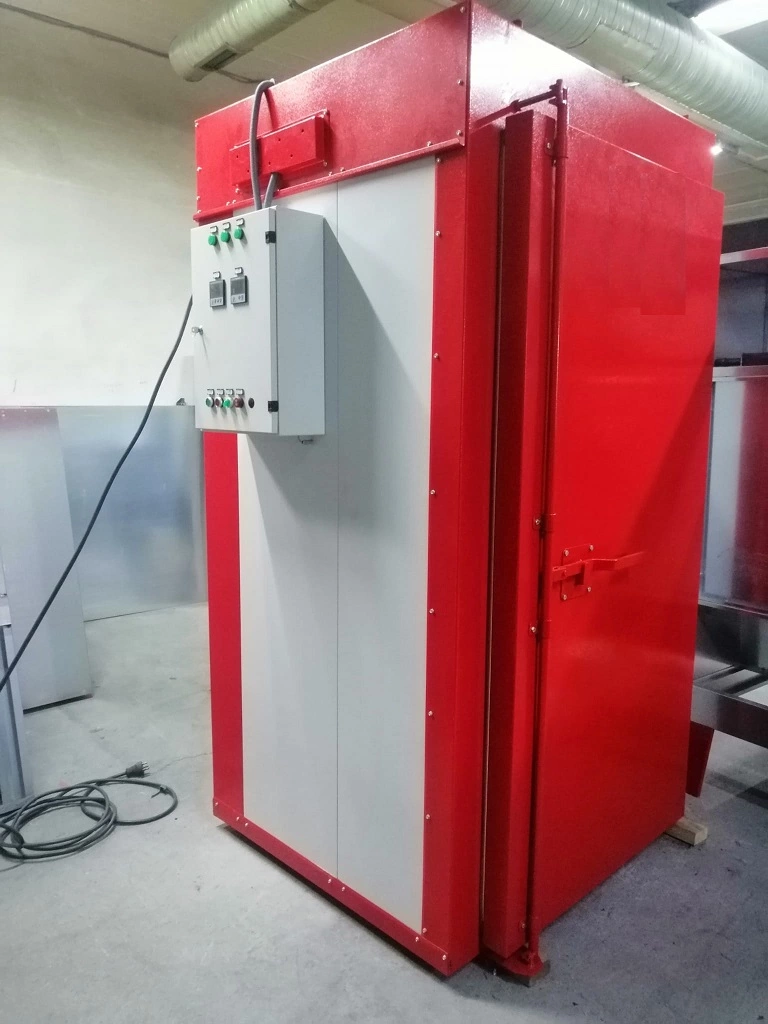
A powder coat oven is a critical component of the powder coating process, providing the heat necessary to cure the powder and create a durable, high-quality finish. These ovens are designed to maintain consistent temperatures and ensure that the powder melts, flows, and bonds to the substrate, forming a strong and aesthetically pleasing surface.
Types of Powder Coat Ovens
- Batch Ovens
Batch powder coat ovens are commonly used in smaller operations or for custom jobs where parts are loaded and unloaded manually. These ovens are ideal for low-volume production or for businesses that coat a variety of different-sized parts. Batch ovens allow for more flexibility in the production process, as parts can be cured in small quantities. - Conveyorized Ovens
Conveyorized powder coat ovens are used in large-scale industrial operations where high production volumes are required. These ovens are part of an automated system in which parts move along a conveyor belt through the coating and curing stages. Conveyorized ovens are highly efficient and reduce the need for manual labor, making them ideal for industries with high throughput demands. - Infrared Curing Ovens
Infrared (IR) powder coat ovens use infrared radiation to heat the powder and cure the coating. These ovens are often used for curing smaller parts or for operations that require fast curing times. Infrared ovens can reduce energy consumption and cure times compared to traditional convection ovens, making them more efficient for certain applications.
Key Features of Powder Coat Ovens
- Temperature Control
Precise temperature control is essential for ensuring consistent curing and avoiding defects in the powder coating finish. Most powder coat ovens are equipped with digital controllers that allow operators to set and maintain the desired temperature throughout the curing process. - Uniform Heat Distribution
One of the critical factors in a powder coat oven’s performance is its ability to distribute heat evenly across all parts of the workpiece. Uneven heating can result in poor adhesion or an inconsistent finish. Modern ovens are designed with advanced airflow systems that ensure uniform temperature throughout the chamber. - Energy Efficiency
With energy consumption being a significant factor in operational costs, many powder coat ovens are designed with energy efficiency in mind. Features such as insulated walls, high-efficiency burners, and heat recovery systems can reduce the amount of energy required to maintain the curing temperature.
Applications of Powder Coat Ovens
Powder coat ovens are used in a wide variety of industries, including:
- Automotive: Curing powder coatings on car bodies, wheels, and other metal components.
- Appliances: Applying protective and decorative coatings to household appliances such as refrigerators and washing machines.
- Furniture: Curing powder coatings on metal furniture frames, providing durable finishes that resist wear and corrosion.
Curing Oven Machine

A curing oven machine is an essential piece of equipment in the powder coating process, responsible for heating the coated parts to the required temperature, causing the powder to melt, flow, and form a durable finish. Curing ovens are also used in other industrial processes, such as adhesive curing, drying, and polymerization, but their role in powder coating is crucial for achieving a long-lasting, high-quality finish.
Types of Curing Ovens
- Convection Curing Ovens
Convection curing ovens are the most commonly used type of oven in powder coating. They use heated air to evenly distribute heat around the coated parts, ensuring a consistent curing process. Convection ovens are available in both batch and continuous configurations, making them suitable for small to large-scale operations. - Infrared (IR) Curing Ovens
Infrared curing ovens use IR radiation to quickly heat the powder and cure the coating. IR ovens are often used for smaller parts or applications where fast curing times are required. Because they can heat parts more rapidly than convection ovens, IR curing ovens can improve production efficiency in certain industries. - Combination Curing Ovens
Combination curing ovens use both convection and infrared heating elements to provide a more versatile curing process. These ovens are often used in industries where different types of coatings or parts need to be cured with varying heat requirements. By combining both heat sources, these ovens offer greater flexibility and efficiency.
Key Features of a Curing Oven Machine
- Precise Temperature Control
The temperature in a curing oven must be carefully controlled to ensure that the powder coating cures correctly. Most curing ovens are equipped with advanced temperature control systems that allow operators to set and maintain the ideal temperature for the specific powder being used. - Airflow and Heat Distribution
Uniform airflow and heat distribution are essential to prevent defects in the cured coating. Modern curing ovens are designed with efficient airflow systems that ensure heat is evenly distributed throughout the oven chamber. This prevents hot spots and ensures that all parts are cured consistently. - Energy Efficiency
With energy costs being a significant factor in powder coating operations, many curing ovens are designed to maximize energy efficiency. Features such as insulated walls, efficient burners, and heat recovery systems help reduce the amount of energy required to operate the oven.
Applications of Curing Ovens in Powder Coating
Curing ovens are used in a wide variety of industries that require durable, high-quality finishes. Some common applications include:
- Automotive Parts: Wheels, frames, and other metal parts are often powder-coated and cured in large-scale curing ovens.
- Appliances: Household appliances like refrigerators and ovens are coated with durable finishes to prevent rust and wear.
- Metal Furniture: Powder-coated metal furniture is cured in curing ovens to achieve finishes that resist chipping and corrosion.
Can Coating Machinery
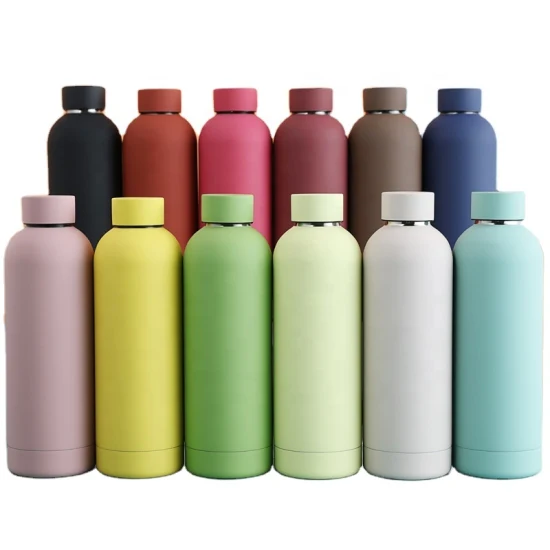
Can coating machinery plays an essential role in the manufacturing of metal cans, particularly in industries like food, beverage, and chemical packaging. The coating process is crucial for both protecting the can from corrosion and ensuring the safety of its contents by preventing interaction between the metal and the stored materials. This machinery is highly specialized to apply both internal and external coatings efficiently and consistently.
Types of Can Coating Machinery
- Internal Coating Machines
Internal coatings are applied to the inner surfaces of cans to prevent the contents from coming into contact with the metal. These coatings are vital in industries like food and beverage, where acids from the contents could react with the metal and compromise the product. Internal coating machines ensure an even application of food-safe or chemically inert coatings inside the can. - External Coating Machines
External coatings protect the outside of the can from environmental damage, corrosion, and wear. These coatings can also provide a surface for labeling and decoration. External coating machines typically apply a primer coat followed by a final decorative or protective topcoat. - Spray Coating Machines
Spray coating machines are commonly used for internal can coating applications. These machines use precision nozzles to apply a fine, even layer of coating material to the interior surfaces of the can, ensuring full coverage without overspray.
Key Features of Can Coating Machinery
- High-Speed Operation
Modern can coating machinery is designed to operate at high speeds, coating hundreds or even thousands of cans per minute. This high throughput is essential for industries with large production volumes, such as beverage can manufacturing. - Precision Application
The application of coatings must be precise to ensure that all surfaces are covered without waste or defects. Advanced can coating machines are equipped with precision nozzles and automated control systems to ensure consistent application on every can. - Temperature Control
Some coatings, especially those used on the exterior of cans, require curing at high temperatures. Can coating machinery is often integrated with curing ovens or equipped with heating elements to ensure that the coatings properly cure, creating a durable finish.
Benefits of Can Coating Machinery
- Corrosion Resistance: By applying protective coatings, the machinery helps prevent cans from corroding, especially in environments where moisture and other corrosive elements are present.
- Increased Shelf Life: For food and beverage cans, the application of internal coatings ensures that the contents remain safe and unspoiled by interaction with the metal, extending the product’s shelf life.
- Customization: Can coating machinery can be adjusted to apply a wide range of coatings, including decorative finishes and labels, allowing manufacturers to create branded products that stand out on store shelves.
Powder Coating Heating Elements

Heating elements are critical components in powder coating systems, particularly in curing ovens. These elements are responsible for generating the heat needed to melt the powder and cause it to flow and bond to the surface of the workpiece. The quality and performance of the heating elements directly impact the efficiency of the powder coating process and the quality of the final finish.
Types of Heating Elements in Powder Coating Ovens
- Electric Heating Elements
Electric heating elements are the most common type used in powder coating ovens. These elements use electrical resistance to generate heat and are often made from materials such as nichrome (nickel-chromium alloy), which can withstand high temperatures and maintain consistent heat output. Electric elements are highly efficient and can be precisely controlled, making them ideal for applications where temperature consistency is critical. - Gas-Fired Heating Elements
Gas-fired heating elements use natural gas or propane to generate heat. These systems are typically used in larger industrial ovens due to their ability to generate high levels of heat quickly and efficiently. Gas-fired systems are often more cost-effective for large-scale operations but may require more complex installation and ventilation systems compared to electric elements. - Infrared Heating Elements
Infrared heating elements generate heat through electromagnetic radiation. These elements are often used in powder coating applications that require fast curing times, as they can heat parts directly without the need for air circulation. Infrared heating is highly efficient and can be targeted to specific areas, making it ideal for curing coatings on small or complex parts.
Factors Affecting the Choice of Heating Elements
- Temperature Requirements
The choice of heating elements depends on the temperature requirements of the powder coating process. Different powders require specific curing temperatures, typically ranging from 350°F to 400°F. The heating elements must be capable of reaching and maintaining these temperatures consistently throughout the curing process. - Energy Efficiency
Energy consumption is a significant consideration when selecting heating elements for powder coating ovens. Electric elements are often more energy-efficient for small to medium-sized operations, while gas-fired elements may offer cost savings for larger facilities that require higher heat output. - Control and Precision
Precise temperature control is essential to prevent overcuring or undercuring of the powder. Modern heating elements are often integrated with digital control systems that allow operators to set and maintain exact temperatures, ensuring consistent quality across all coated parts.
Maintenance and Longevity of Heating Elements
Proper maintenance is critical to ensuring the longevity and performance of heating elements. Regular inspection of the elements for wear, corrosion, or damage can help prevent unexpected failures and ensure that the powder coating system continues to operate efficiently. Additionally, keeping the elements clean and free from dust or debris can improve their performance and reduce energy consumption.
Aluminum Powder Coating Machine
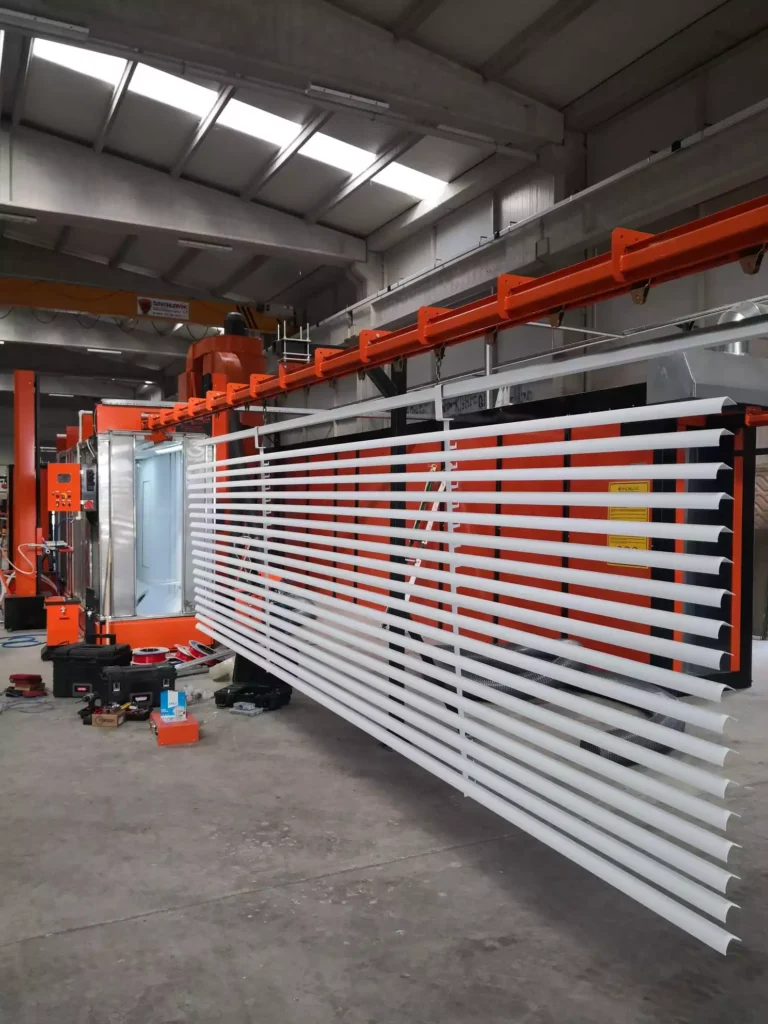
Aluminum powder coating machines are specialized systems designed to apply powder coatings to aluminum surfaces. Aluminum is widely used in industries such as construction, automotive, and aerospace due to its strength, lightweight properties, and resistance to corrosion. However, to further enhance its durability and appearance, aluminum is often coated with a protective powder layer.
Key Components of an Aluminum Powder Coating Machine
- Powder Spray Gun
The powder spray gun is the core component of the powder coating machine. It electrostatically charges the powder particles, ensuring they adhere evenly to the aluminum surface. For aluminum parts, the spray gun must be calibrated to account for the conductivity of the metal, ensuring uniform coverage. - Powder Coating Booth
The powder coating booth contains the powder during the application process, ensuring a clean and controlled environment. Aluminum powder coating machines are often equipped with booths that have advanced filtration systems to recover excess powder, improving cost-efficiency and reducing waste. - Curing Oven
Once the aluminum part is coated, it is cured in a specialized oven that melts the powder and causes it to flow and bond to the surface. The curing oven is designed to maintain precise temperatures to ensure that the coating adheres properly and forms a smooth, durable finish.
Benefits of Powder Coating for Aluminum
- Enhanced Corrosion Resistance
Powder coating provides an additional layer of protection against corrosion, which is particularly important for aluminum parts exposed to harsh environments, such as outdoor structures or automotive components. The powder coating prevents moisture and other corrosive elements from penetrating the metal. - Improved Aesthetic Appeal
Aluminum powder coating allows for a wide range of colors and finishes, from high-gloss to matte textures. This makes it a popular choice for architectural applications, where aesthetics are as important as functionality. Powder coating also provides a more uniform and durable finish compared to traditional liquid paints. - Durability and Scratch Resistance
Powder-coated aluminum is highly resistant to chipping, scratching, and fading. This durability makes it an ideal choice for products that need to maintain their appearance over time, such as window frames, doors, and automotive parts.
Applications of Aluminum Powder Coating Machines
- Architectural Components: Aluminum used in windows, doors, and curtain walls is often powder-coated to improve its resistance to the elements and enhance its aesthetic appeal.
- Automotive Parts: Powder coating is applied to aluminum wheels, engine components, and other automotive parts to protect them from corrosion and wear.
- Furniture: Outdoor aluminum furniture is powder-coated to prevent rusting and provide a durable, weather-resistant finish.
Zinc Phosphate Conversion Coating
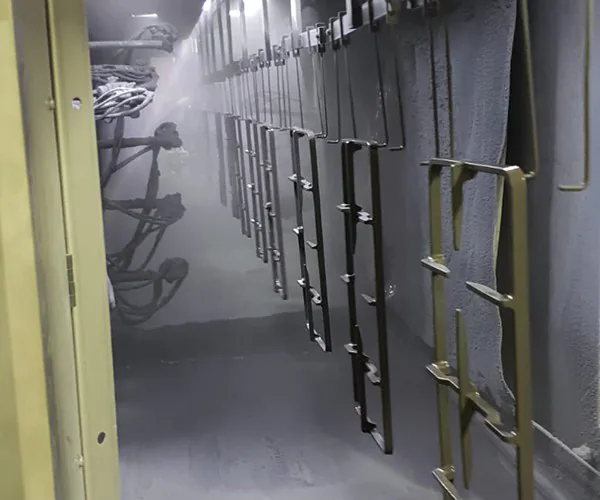
Zinc phosphate conversion coating is a widely used surface treatment process that improves the adhesion of powder coatings and enhances corrosion resistance. The coating is applied to metal surfaces, creating a crystalline layer that helps bind the powder to the substrate, particularly in environments where corrosion protection is essential.
How Zinc Phosphate Conversion Coating Works
The zinc phosphate coating process involves immersing the metal part in a solution containing zinc phosphate chemicals. The solution reacts with the metal surface, forming a layer of zinc phosphate crystals. This layer creates a textured surface that improves the adhesion of subsequent coatings, such as powder or paint, and provides a degree of corrosion protection on its own.
Steps in the Zinc Phosphate Conversion Coating Process
- Surface Cleaning
Before applying the zinc phosphate coating, the metal surface must be thoroughly cleaned to remove oils, dirt, and other contaminants. This step is crucial, as any remaining residue can prevent the zinc phosphate from bonding properly with the metal. - Zinc Phosphate Bath
After cleaning, the metal part is immersed in a zinc phosphate bath. The duration of the immersion depends on the desired thickness of the coating and the type of metal being treated. The solution reacts with the metal surface, forming a crystalline zinc phosphate layer. - Rinsing
Once the coating is applied, the part is rinsed to remove any excess chemicals. This step ensures that no residue remains on the surface, which could interfere with the adhesion of subsequent coatings. - Drying and Inspection
After rinsing, the part is dried and inspected for uniformity. A well-applied zinc phosphate coating should appear as a thin, even layer of crystals across the entire surface of the part.
Benefits of Zinc Phosphate Conversion Coating
- Improved Adhesion
The primary benefit of zinc phosphate coating is its ability to improve the adhesion of powder coatings or paints. The crystalline structure of the coating provides a roughened surface that allows the powder to bond more effectively with the metal, resulting in a stronger and more durable finish. - Corrosion Resistance
Zinc phosphate conversion coating provides an additional layer of protection against corrosion. While it is not as effective as a full powder coating or paint system on its own, it enhances the overall corrosion resistance when used as part of a multi-coating process. - Enhanced Durability
When combined with powder coating, zinc phosphate conversion coating improves the durability of metal parts. It helps prevent chipping, peeling, and other forms of damage that can occur over time, especially in harsh environments.
Applications of Zinc Phosphate Conversion Coating
Zinc phosphate conversion coating is used in a variety of industries, including:
- Automotive: Used on car bodies and components to improve the adhesion of primer and paint while providing corrosion resistance.
- Construction: Applied to metal structures, such as steel beams and girders, to protect them from corrosion and enhance their lifespan.
- Appliance Manufacturing: Household appliances that are exposed to moisture, such as washing machines or refrigerators, benefit from the added protection offered by zinc phosphate conversion coating.
Powder Coating Equipment
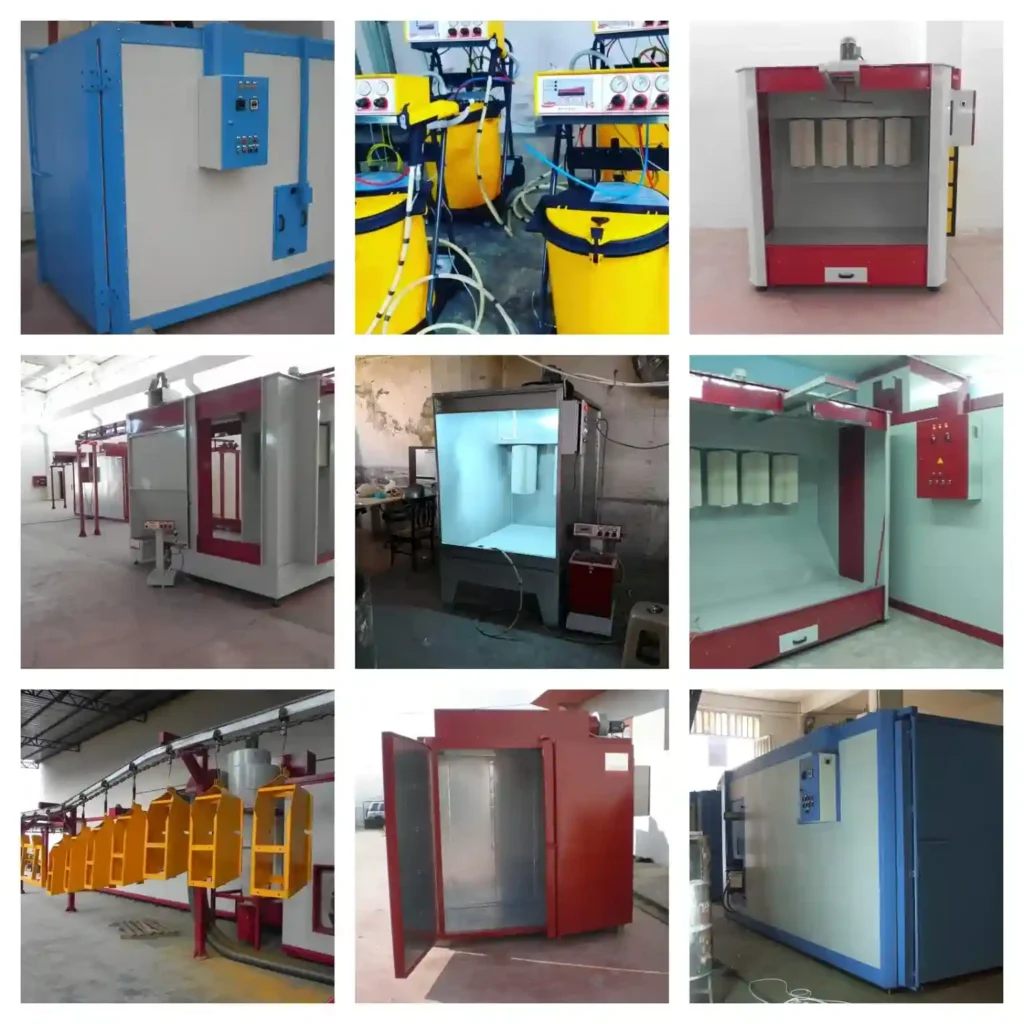
Powder coating equipment is an essential component in the powder coating process, ensuring that a durable and high-quality finish is applied to a wide range of materials. Powder coating is a dry finishing process where fine particles of powder are electrostatically charged and sprayed onto a surface, adhering to the material and providing a strong protective coating. The process is popular for its durability, efficiency, and environmental friendliness compared to traditional liquid paints. Key industries such as automotive, aerospace, appliance manufacturing, and architecture heavily rely on powder coating for their products.
Types of Powder Coating Equipment
- Spray Guns (Electrostatic)
The electrostatic spray gun is the cornerstone of powder coating equipment. It charges powder particles using electricity, making them adhere to the surface of grounded objects. Spray guns can be either manual or automatic, depending on the application. Manual guns are used in smaller operations or custom jobs, while automatic guns are integrated into large-scale production lines. - Powder Coating Booths
A powder coating booth contains the powder within a designated space, ensuring that the work environment remains clean and free from powder contamination. These booths are equipped with filtration systems that collect excess powder, allowing it to be reused, making the process more efficient and reducing waste. There are two primary types of booths: open-face booths, which are ideal for smaller operations, and enclosed booths, typically used in large-scale or automated setups. - Curing Ovens
Once the powder is applied, curing ovens heat the coated part to the required temperature, typically between 350°F and 400°F, to melt the powder and form a smooth, durable finish. These ovens come in various sizes, including batch ovens for smaller operations and conveyorized ovens for continuous, high-volume production. The type of curing oven used depends on the size and type of part being coated. - Conveyor Systems
For high-production environments, conveyor systems move parts automatically through the various stages of the powder coating process, including surface preparation, coating, and curing. These systems are highly efficient, reducing manual labor and increasing throughput. They are widely used in industries where speed and consistency are critical, such as in automotive and appliance manufacturing.
Benefits of Powder Coating Equipment
- Durability
Powder-coated surfaces are highly resistant to chipping, scratching, and corrosion, providing long-lasting protection. This durability makes powder coating the preferred method for products exposed to harsh environments, such as outdoor furniture, automotive parts, and industrial machinery. - Efficiency
Powder coating equipment is designed to minimize waste. The powder that does not adhere to the surface during the coating process is captured by recovery systems and reused, making it more cost-effective and environmentally friendly than traditional liquid coatings. - Environmentally Friendly
Powder coating produces virtually no volatile organic compounds (VOCs), which are harmful to both the environment and workers’ health. The absence of solvents in powder coating also makes it easier to comply with environmental regulations and reduces the need for costly waste disposal. - Versatility
Powder coating equipment can be used on a wide range of materials, including metals, plastics, and glass. This versatility allows businesses to coat various products without the need for multiple types of equipment, streamlining operations and reducing costs.
Challenges and Considerations
- Initial Investment
The initial cost of setting up a powder coating operation can be significant, especially for automated systems. Businesses must consider the long-term benefits of powder coating, such as reduced waste and increased durability, to justify the upfront costs. - Maintenance
Regular maintenance is essential for ensuring that powder coating equipment operates at peak efficiency. This includes cleaning spray guns, replacing filters in the powder booths, and ensuring that ovens are heating evenly. Neglecting maintenance can lead to uneven coatings, equipment breakdowns, and increased operational costs. - Training
Skilled operators are crucial for successful powder coating operations. Whether using manual spray guns or overseeing automated systems, operators must be trained to ensure proper coating application, troubleshoot equipment issues, and maintain safety protocols.
Applications of Powder Coating Equipment
Powder coating equipment is used across a wide range of industries, each with unique requirements:
- Automotive Industry: Powder coating is widely used to finish car parts, including wheels, engine components, and frames, due to its durability and corrosion resistance.
- Appliance Manufacturing: Many household appliances, such as refrigerators and washing machines, are powder coated to protect against wear and corrosion.
- Architectural Applications: Aluminum window frames, railings, and other architectural components are often powder-coated to provide a protective and aesthetically pleasing finish.
- Industrial Equipment: Machinery and equipment used in harsh industrial environments benefit from the protective properties of powder coatings, extending the life of the equipment and reducing maintenance costs.
Future Trends in Powder Coating Equipment
The powder coating industry continues to evolve, with new technologies and innovations being developed to improve efficiency, reduce costs, and expand the range of materials that can be coated.
- Automation and Robotics
The increasing demand for high production rates and consistent quality has led to the development of automated powder coating systems. Robotic arms equipped with spray guns can apply coatings with greater precision, reducing waste and improving the uniformity of the finish. Automation also reduces the need for manual labor, lowering operational costs and increasing efficiency. - Advanced Curing Technologies
As energy efficiency becomes a more significant concern, new curing technologies, such as infrared (IR) and ultraviolet (UV) curing, are being developed. These technologies offer faster curing times and lower energy consumption compared to traditional convection ovens, making them more cost-effective and environmentally friendly. - Sustainable Powders
The development of eco-friendly powders that require lower curing temperatures or emit fewer emissions during the coating process is an area of ongoing research. These powders can help businesses reduce their environmental impact while maintaining the high performance of traditional powder coatings.
In conclusion, powder coating equipment plays a vital role in modern manufacturing, providing businesses with an efficient, cost-effective, and environmentally friendly way to protect and enhance their products. As technology advances, the industry is likely to see continued improvements in equipment efficiency, sustainability, and versatility, making powder coating an increasingly attractive option for a wide range of applications.
11 Tank Process for Powder Coating
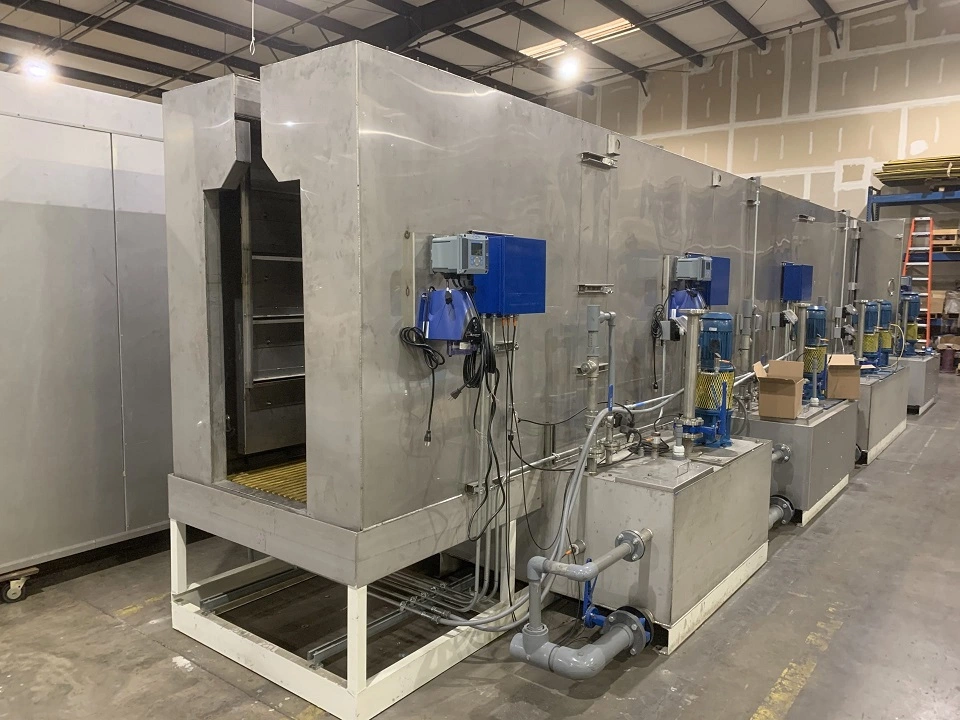
The 11 tank process for powder coating is a highly effective surface treatment method used to prepare metal parts, particularly steel and aluminum, before the powder coating application. This pre-treatment process ensures that the metal surface is thoroughly cleaned, degreased, and conditioned to improve the adhesion and durability of the powder coating. The 11 tank process involves a series of chemical baths and rinses, each with a specific function, culminating in a surface that is ideal for powder coating application.
This process is widely used in industries such as automotive, construction, aerospace, and consumer goods manufacturing, where high-quality, durable finishes are required to protect metal components from corrosion, wear, and environmental factors. The 11 tank process plays a critical role in enhancing the performance and longevity of the powder-coated finish, making it a crucial step in the overall powder coating workflow.
Overview of the 11 Tank Process
The 11 tank process consists of multiple stages that involve cleaning, degreasing, phosphating, passivation, and rinsing. Each tank contains a specific chemical solution designed to prepare the metal surface for the next step, ultimately resulting in a surface that is clean, free from contaminants, and ready to accept the powder coating.
Here is an overview of the steps involved in the 11 tank process:
- Tank 1: Degreasing
The first tank is used for degreasing the metal surface, removing oils, greases, and other organic contaminants that may interfere with the adhesion of the powder coating. An alkaline degreasing solution is typically used for this purpose. Degreasing is critical for ensuring that the surface is clean and free from substances that could prevent the powder from bonding to the metal.- Purpose: Remove oils, grease, and organic contaminants.
- Solution: Alkaline degreaser.
- Tank 2: Water Rinse
After degreasing, the part is rinsed with water to remove any residual degreasing solution. This rinse helps prevent contamination of subsequent tanks and ensures that the surface is clean before moving to the next stage.- Purpose: Remove degreasing chemicals.
- Solution: Water.
- Tank 3: Acid Pickling
In the third tank, the metal is treated with an acid pickling solution to remove rust, mill scale, and oxidation from the surface. Acid pickling is particularly important for steel parts that may have rust or other corrosion that needs to be removed before coating. The acid etches the surface of the metal, creating a slightly rough texture that improves the adhesion of the powder coating.- Purpose: Remove rust, mill scale, and oxides from the metal surface.
- Solution: Acid pickling solution.
- Tank 4: Water Rinse
Another water rinse is performed after acid pickling to remove any residual acid from the surface. This rinse helps neutralize the acid and ensures that the surface is clean before moving on to the next step.- Purpose: Remove acid residues.
- Solution: Water.
- Tank 5: Surface Activation
In this stage, the metal surface is treated with a surface activation solution that promotes better adhesion of the phosphate coating. Surface activation creates microcrystals on the metal surface, which act as nucleation sites for the formation of the phosphate layer in the next step. This step is essential for achieving a uniform and durable phosphate coating.- Purpose: Promote better adhesion of the phosphate coating.
- Solution: Surface activation solution.
- Tank 6: Zinc Phosphating
The sixth tank is where the zinc phosphate coating is applied to the metal surface. Zinc phosphate is a crystalline coating that enhances the corrosion resistance of the metal and improves the adhesion of the powder coating. This layer acts as a protective barrier, helping to prevent rust and oxidation while also providing a textured surface that helps the powder coating adhere more effectively.- Purpose: Apply a zinc phosphate coating for corrosion resistance and improved adhesion.
- Solution: Zinc phosphate solution.
- Tank 7: Water Rinse
After the phosphating stage, the part is rinsed again with water to remove any excess phosphate solution. This rinse ensures that no chemical residues remain on the surface that could interfere with the powder coating application.- Purpose: Remove excess phosphate solution.
- Solution: Water.
- Tank 8: Chromic Acid Passivation (Optional)
In some cases, a chromic acid passivation stage is included to further enhance the corrosion resistance of the metal. This step is particularly useful for parts that will be exposed to harsh environments, such as outdoor or marine applications. The chromic acid passivation layer seals the zinc phosphate coating, providing an additional barrier against corrosion.- Purpose: Enhance corrosion resistance (optional).
- Solution: Chromic acid passivation.
- Tank 9: Water Rinse
Another water rinse is performed after the passivation stage to remove any remaining passivation chemicals from the surface. This rinse helps ensure that the surface is clean and ready for the final stages of the process.- Purpose: Remove passivation chemicals.
- Solution: Water.
- Tank 10: Deionized Water Rinse
The penultimate stage involves rinsing the part with deionized water. Deionized water is used to ensure that no mineral deposits or impurities are left on the metal surface, which could affect the quality of the powder coating. This rinse helps to achieve a clean, residue-free surface before drying.
- Purpose: Ensure a clean, residue-free surface.
- Solution: Deionized water.
- Tank 11: Drying
The final stage of the 11 tank process is drying. The part is dried using hot air or another method to remove all moisture from the surface. This is critical for preventing flash rusting or moisture entrapment, which could affect the quality and adhesion of the powder coating.
- Purpose: Remove moisture from the surface.
- Method: Hot air drying or similar method.
Benefits of the 11 Tank Process for Powder Coating
- Improved Powder Coating Adhesion
The 11 tank process ensures that the metal surface is thoroughly cleaned and treated, providing an ideal foundation for powder coating. The zinc phosphate coating and surface activation steps help create a textured surface that allows the powder to adhere more effectively, reducing the risk of peeling, flaking, or delamination. - Enhanced Corrosion Resistance
Zinc phosphate and optional passivation layers provide excellent corrosion protection for metal parts. By creating a barrier between the metal surface and environmental factors such as moisture, oxygen, and chemicals, the 11 tank process helps extend the lifespan of powder-coated parts, reducing the need for maintenance or repairs. - Uniform Surface Preparation
The multiple stages of the 11 tank process ensure that the metal surface is prepared uniformly, with no contaminants or residues that could interfere with the powder coating. This uniformity is essential for achieving a consistent, high-quality finish, especially on large or complex parts. - Versatility Across Metals
The 11 tank process can be used on a wide range of metals, including steel, aluminum, and galvanized steel. This versatility makes it suitable for a variety of industries and applications, from automotive parts and construction materials to consumer goods and electronics. - Increased Durability
By combining thorough cleaning, surface activation, and zinc phosphating, the 11 tank process enhances the overall durability of the powder coating. Parts treated with this process are better able to withstand wear, impact, and environmental exposure, ensuring long-lasting performance.
Applications of the 11 Tank Process
- Automotive Industry
The 11 tank process is widely used in the automotive industry to prepare steel and aluminum components for powder coating. Parts such as chassis components, engine blocks, and body panels undergo the 11 tank process to ensure that they are corrosion-resistant and ready for a durable powder-coated finish. - Construction and Infrastructure
In the construction industry, the 11 tank process is used to prepare steel beams, bridges, and other metal structures for powder coating. The process ensures that these components are protected from corrosion and wear, helping to extend the lifespan of critical infrastructure. - Appliance Manufacturing
Appliance manufacturers use the 11 tank process to prepare metal panels, frames, and other components for powder coating. This process ensures that the powder coating adheres properly to the metal, providing a smooth, durable finish that can withstand daily use. - Aerospace Industry
In aerospace applications, the 11 tank process is used to prepare aluminum and steel parts for powder coating. These parts must be corrosion-resistant and able to withstand the extreme conditions of flight, making the 11 tank process an essential step in the manufacturing process. - General Manufacturing
Many general manufacturing industries, including consumer goods, electronics, and industrial equipment, rely on the 11 tank process to prepare metal parts for powder coating. The process ensures that these parts have a clean, corrosion-resistant surface that is ready for a high-quality finish.
Challenges of the 11 Tank Process
- Complexity and Time-Consuming
The 11 tank process involves multiple stages, each requiring careful control and monitoring. This can make the process time-consuming and complex, especially for large-scale production. Manufacturers must ensure that each stage is performed correctly to achieve the desired results. - Water and Chemical Usage
The process requires significant amounts of water and chemicals, particularly for the rinsing stages. Managing water usage and chemical waste is critical to minimizing the environmental impact of the process. Many manufacturers implement water recycling and waste treatment systems to reduce their environmental footprint. - Maintenance of Equipment
The equipment used in the 11 tank process, including immersion tanks, spray nozzles, and drying systems, requires regular maintenance to ensure consistent performance. Any malfunction or contamination in one stage of the process can affect the quality of the entire batch, leading to defects or rework.
Best Practices for the 11 Tank Process
- Regular Monitoring and Control
Closely monitor and control the chemical concentrations, temperatures, and immersion times in each tank to ensure that the process runs smoothly and consistently. Proper process control helps prevent issues such as under-phosphating or over-pickling, which can affect the quality of the powder coating. - Efficient Water and Chemical Management
Implement water recycling systems and chemical management practices to reduce the environmental impact of the 11 tank process. This includes treating and recycling rinse water, as well as minimizing chemical waste through careful monitoring and dosing of the phosphating and pickling solutions. - Surface Preparation Consistency
Ensure that the metal surface is consistently prepared across all parts. This may involve regularly cleaning and maintaining the immersion tanks and spray systems to prevent contamination or uneven treatment. Consistent surface preparation is critical for achieving a uniform powder-coated finish. - Equipment Maintenance and Calibration
Regularly maintain and calibrate the equipment used in the 11 tank process to ensure that it operates efficiently and consistently. This includes inspecting and cleaning the tanks, checking the condition of spray nozzles, and calibrating the drying systems.
Conclusion
The 11 tank process is a comprehensive and highly effective method for preparing metal parts for powder coating. By thoroughly cleaning, treating, and conditioning the metal surface, this process ensures that powder coatings adhere properly and provide long-lasting protection against corrosion and wear. Although the process is complex and requires careful control, the benefits of improved adhesion, enhanced corrosion resistance, and increased durability make it a valuable step in the powder coating workflow. By following best practices and maintaining the equipment properly, manufacturers can achieve high-quality, consistent results across a wide range of applications.
7 Tank Process for Powder Coating

The 7 tank process for powder coating is another method of surface pre-treatment used to prepare metal surfaces before the application of powder coatings. While it is a more streamlined version compared to the 11 tank process, it still provides an effective way to clean, degrease, and apply a protective phosphate coating to metal parts. This process is used in various industries such as automotive, construction, and manufacturing, where a durable and corrosion-resistant powder coating is essential.
The 7 tank process involves fewer stages than the 11 tank process but retains the core steps necessary for achieving a clean, corrosion-resistant surface. By eliminating some of the more complex steps, the 7 tank process is ideal for operations where speed and efficiency are important, yet surface quality and corrosion protection are still critical. This section will explore the 7 tank process in detail, its benefits, applications, and best practices for successful surface pre-treatment.
Overview of the 7 Tank Process
The 7 tank process is a series of chemical treatments designed to prepare metal surfaces for powder coating. Like the 11 tank process, it involves cleaning, degreasing, phosphating, and rinsing stages, but it is optimized for applications that may not require the full complexity of the 11 tank process. The goal of the 7 tank process is to create a surface that is free of contaminants and ready for powder coating, while also improving the adhesion and durability of the coating.
Here are the stages involved in the 7 tank process:
- Tank 1: Degreasing
The first stage in the 7 tank process is degreasing, where the metal part is cleaned to remove any oils, grease, and other organic contaminants. An alkaline degreasing solution is typically used for this purpose. Degreasing is essential for ensuring that the surface is clean and free of contaminants that could interfere with the adhesion of the powder coating.- Purpose: Remove oils, grease, and organic contaminants.
- Solution: Alkaline degreasing solution.
- Tank 2: Water Rinse
After degreasing, the part is rinsed with water to remove any residual degreasing solution. This rinse ensures that no contaminants remain on the surface before moving on to the next step, helping to prevent interference with the phosphating stage.- Purpose: Remove degreasing chemicals.
- Solution: Water.
- Tank 3: Acid Pickling
The third stage is acid pickling, where the metal is treated with an acidic solution to remove rust, mill scale, and oxides. This step is particularly important for steel parts that may have rust or surface oxidation. Acid pickling creates a clean, bare metal surface that is ready for the phosphate coating, improving the coating’s adhesion and corrosion resistance.- Purpose: Remove rust, mill scale, and oxides.
- Solution: Acid pickling solution.
- Tank 4: Water Rinse
After the acid pickling stage, the part is rinsed again with water to remove any residual acid from the surface. This rinse is important for neutralizing the acid and preventing any unwanted chemical reactions in the subsequent phosphating stage.- Purpose: Remove acid residues.
- Solution: Water.
- Tank 5: Zinc Phosphating
The fifth stage is the application of a zinc phosphate coating. This phosphate layer improves the corrosion resistance of the metal and provides a roughened surface that enhances the adhesion of the powder coating. Zinc phosphating is a critical step in the 7 tank process, as it provides the primary protection against corrosion and improves the overall durability of the powder-coated finish.- Purpose: Apply a zinc phosphate coating for corrosion resistance and improved adhesion.
- Solution: Zinc phosphate solution.
- Tank 6: Water Rinse
Following the phosphating stage, the part is rinsed with water to remove any excess phosphate solution. This rinse ensures that no residual chemicals remain on the surface that could interfere with the powder coating application.- Purpose: Remove excess phosphate solution.
- Solution: Water.
- Tank 7: Drying
The final stage in the 7 tank process is drying. The part is thoroughly dried using hot air or another method to remove all moisture from the surface. Proper drying is essential to prevent flash rusting or moisture entrapment, which could affect the quality and adhesion of the powder coating.- Purpose: Remove moisture from the surface.
- Method: Hot air drying or similar method.
Benefits of the 7 Tank Process for Powder Coating
- Streamlined and Efficient
The 7 tank process is a more streamlined version of the 11 tank process, making it ideal for operations that require faster throughput without sacrificing surface quality. By eliminating some of the more complex stages, the 7 tank process allows manufacturers to prepare metal surfaces quickly and efficiently, reducing production times and costs. - Effective Corrosion Protection
Zinc phosphate coating, which is a key part of the 7 tank process, provides excellent corrosion protection for metal parts. The phosphate layer acts as a barrier between the metal and corrosive elements, such as moisture and oxygen, helping to prevent rust and oxidation. This corrosion resistance is particularly important for parts that will be exposed to harsh environments. - Improved Adhesion for Powder Coating
One of the primary goals of the 7 tank process is to improve the adhesion of the powder coating. The zinc phosphate layer creates a textured surface that allows the powder coating to bond more effectively to the metal, reducing the risk of peeling, flaking, or delamination. This strong adhesion ensures that the powder coating remains intact, even under mechanical stress or environmental exposure. - Cost-Effective Surface Preparation
The 7 tank process is a cost-effective method of preparing metal surfaces for powder coating. It uses fewer stages and fewer chemicals compared to the 11 tank process, reducing the overall cost of the pre-treatment process. This makes it an attractive option for manufacturers who need to prepare large volumes of parts without significantly increasing production costs. - Versatility Across Different Metals
Like the 11 tank process, the 7 tank process can be used on a variety of metals, including steel and aluminum. This versatility makes it suitable for a wide range of industries and applications, from automotive components to consumer goods and industrial equipment.
Applications of the 7 Tank Process
- Automotive Industry
The 7 tank process is commonly used in the automotive industry to prepare steel and aluminum components for powder coating. Parts such as chassis components, engine blocks, and suspension parts benefit from the corrosion resistance and improved adhesion provided by the 7 tank process, ensuring long-lasting protection in harsh environments. - Construction and Infrastructure
In the construction industry, the 7 tank process is used to prepare steel beams, railings, and other metal structures for powder coating. The process helps protect these components from rust and corrosion, extending their lifespan and reducing maintenance costs. - Appliance Manufacturing
Appliance manufacturers use the 7 tank process to prepare metal panels, frames, and other components for powder coating. The process ensures that the powder coating adheres properly to the metal, providing a smooth, durable finish that can withstand daily use. - General Manufacturing
The 7 tank process is widely used in general manufacturing to prepare metal parts for powder coating. This includes consumer goods, electronics, and industrial equipment. The process ensures that metal parts have a clean, corrosion-resistant surface that is ready for a high-quality powder-coated finish.
Challenges of the 7 Tank Process
- Limited Corrosion Protection Compared to 11 Tank Process
While the 7 tank process provides good corrosion protection, it may not be as effective as the 11 tank process for parts exposed to extreme environments, such as marine or outdoor applications. For parts that require enhanced corrosion resistance, the 11 tank process or additional passivation steps may be more appropriate. - Process Control and Maintenance
As with any surface treatment process, the 7 tank process requires careful monitoring and control to ensure consistent results. The concentration of the chemicals, immersion times, and rinse stages must be carefully controlled to achieve the desired level of surface preparation. Regular maintenance of the equipment is also necessary to prevent contamination or inconsistent treatment. - Water and Chemical Usage
The 7 tank process requires significant amounts of water and chemicals, particularly for the rinsing stages. Managing water usage and chemical waste is important to minimize the environmental impact of the process. Manufacturers must implement water recycling and waste treatment systems to reduce their environmental footprint and comply with regulations.
Best Practices for the 7 Tank Process
- Regular Monitoring of Chemical Concentrations
Ensure that the concentrations of the degreasing, acid pickling, and zinc phosphating solutions are regularly monitored and adjusted as needed. Maintaining the proper chemical balance is essential for achieving consistent results and ensuring that the surface is properly prepared for powder coating. - Efficient Water Management
Implement water recycling and treatment systems to reduce water usage and minimize waste. The rinse stages in the 7 tank process can consume large amounts of water, so recycling rinse water and treating it before disposal can help reduce the environmental impact of the process. - Ensure Proper Surface Drying
Thorough drying of the metal surface after the final rinse is critical to preventing flash rusting or moisture entrapment, which could affect the quality of the powder coating. Use hot air drying or other methods to ensure that all moisture is removed from the surface before the powder coating is applied. - Regular Equipment Maintenance
Regularly inspect and maintain the tanks, immersion systems, and drying equipment used in the 7 tank process. Preventive maintenance helps ensure that the process runs smoothly and consistently, reducing the risk of defects or rework.
Conclusion
The 7 tank process for powder coating is an efficient and cost-effective method of preparing metal surfaces for powder coating. By providing thorough cleaning, degreasing, and zinc phosphating, this process improves the adhesion of the powder coating and enhances the corrosion resistance of the metal. While it may not offer the same level of protection as the 11 tank process, the 7 tank process is ideal for applications where speed, efficiency, and cost-effectiveness are important. By following best practices for process control, water management, and equipment maintenance, manufacturers can achieve high-quality, consistent results across a wide range of industries and applications.
Aluminium Section Powder Coating

Aluminium section powder coating is the process of applying a protective and decorative powder coating to aluminum profiles and sections used in a variety of industries, including construction, automotive, and furniture manufacturing. Powder coating aluminum sections is highly valued for its ability to provide corrosion resistance, aesthetic appeal, and durability, all while being an environmentally friendly finishing process.
Aluminum sections are widely used in applications such as window frames, doors, curtain walls, structural components, and extrusions. These sections often require a durable finish that can withstand environmental exposure, mechanical wear, and long-term use. Powder coating provides a high-quality, durable finish that not only enhances the appearance of aluminum but also protects it from corrosion, UV radiation, and other external factors.
In this section, we will explore the process of powder coating aluminum sections, the benefits of this method, and the best practices for achieving optimal results.
The Powder Coating Process for Aluminium Sections
The powder coating process for aluminum sections involves several key stages, including surface preparation, powder application, and curing. Each stage is crucial for ensuring that the powder coating adheres properly to the aluminum surface and provides long-lasting protection.
- Surface Preparation
Proper surface preparation is essential for achieving a high-quality powder coating finish on aluminum sections. The smooth surface of aluminum can make it difficult for powder to adhere properly, so it must be cleaned and treated before the powder is applied. Surface preparation typically involves the following steps:- Degreasing: The aluminum section is cleaned to remove any oils, grease, or contaminants that could interfere with the adhesion of the powder coating.
- Etching or Sandblasting: The surface of the aluminum is etched or sandblasted to create a slightly rough texture that improves the adhesion of the powder. This step also removes any oxidation or corrosion that may be present on the surface.
- Pre-Treatment (Chromate or Phosphate Coating): In many cases, a chromate or phosphate pre-treatment is applied to further enhance the adhesion of the powder coating and improve the corrosion resistance of the aluminum section.
- Powder Application
After the aluminum section has been properly prepared, the powder coating is applied using an electrostatic spray gun. The powder, which consists of fine particles of resin and pigment, is charged electrostatically and sprayed onto the grounded aluminum surface. The electrostatic charge causes the powder particles to cling to the surface, creating an even, uniform layer of powder.- Electrostatic Spray Gun: The spray gun imparts an electrostatic charge to the powder particles, ensuring that they are attracted to the grounded aluminum surface. This allows for precise control over the application process, reducing waste and ensuring consistent coverage.
- Powder Recovery System: Excess powder that does not adhere to the surface is collected and recycled using a powder recovery system. This helps minimize waste and improve the cost-efficiency of the powder coating process.
- Curing
Once the powder has been applied, the aluminum section is placed in a curing oven, where it is heated to a specific temperature (typically between 350°F and 400°F). The heat causes the powder to melt, flow, and bond to the surface of the aluminum, creating a smooth, durable finish. The curing process is critical for ensuring that the powder coating fully adheres to the aluminum and achieves the desired level of hardness and durability.- Convection Ovens: Convection ovens use heated air to cure the powder coating evenly across the entire surface of the aluminum section. These ovens are ideal for larger or more complex parts.
- Infrared (IR) Ovens: IR ovens use infrared radiation to directly heat the surface of the aluminum section, resulting in faster curing times and improved energy efficiency. These ovens are often used for smaller sections or applications where quick turnaround times are required.
Benefits of Aluminium Section Powder Coating
- Corrosion Resistance
Powder coating provides a protective barrier that shields aluminum sections from corrosion. While aluminum is naturally resistant to corrosion due to its oxide layer, this layer can degrade over time, especially in harsh environments. Powder coating adds an additional layer of protection, ensuring that the aluminum section remains resistant to rust, oxidation, and other forms of corrosion. This is particularly important in outdoor applications, where exposure to moisture, salt, and pollutants can accelerate corrosion. - Durability and Mechanical Resistance
Powder-coated aluminum sections are highly durable and resistant to mechanical damage such as scratches, chips, and impacts. The hard, protective layer created by the powder coating is ideal for applications where the aluminum section will be subjected to heavy use or wear, such as in architectural components, industrial machinery, or transportation equipment. This durability helps extend the lifespan of the aluminum section and reduces the need for maintenance or repairs. - UV and Weather Resistance
Powder coatings are designed to withstand exposure to UV radiation, moisture, and extreme temperatures without degrading or fading. This makes powder-coated aluminum sections ideal for outdoor applications, such as building facades, window frames, and curtain walls, where long-term exposure to the elements is inevitable. The powder coating protects the aluminum from discoloration, cracking, and other forms of weather-related damage, ensuring that the finish remains vibrant and intact over time. - Aesthetic Flexibility
Powder coating allows for a wide range of colors, finishes, and textures, making it an ideal solution for enhancing the appearance of aluminum sections. From glossy to matte finishes, and from smooth to textured surfaces, powder coatings can be customized to achieve the desired aesthetic. This versatility is particularly valuable in architectural applications, where the appearance of the aluminum section plays a significant role in the overall design of a building or structure. - Environmentally Friendly Process
Powder coating is an environmentally friendly finishing process compared to traditional liquid coatings. It produces minimal waste, as excess powder can be collected and reused, and it contains no volatile organic compounds (VOCs), which are harmful to the environment. Additionally, the powder coating process is energy-efficient, particularly when using infrared curing ovens, which further reduces its environmental impact. - Cost-Efficiency
Powder coating is a cost-effective solution for finishing aluminum sections. The ability to recover and reuse excess powder reduces material waste, while the durability of the finish minimizes the need for touch-ups or repairs. Additionally, powder coating can be applied in a single coat, which helps reduce labor and production costs compared to traditional multi-coat liquid finishes.
Applications of Aluminium Section Powder Coating
- Architectural Applications
Powder-coated aluminum sections are widely used in the construction and architectural industries for applications such as window frames, doors, curtain walls, and structural components. The powder coating provides a durable, corrosion-resistant finish that enhances the appearance of the building while also protecting the aluminum from the elements. Architects and designers often specify powder-coated aluminum for both functional and aesthetic reasons, as it offers long-term protection and a wide range of design options. - Automotive Industry
The automotive industry uses powder-coated aluminum sections for a variety of components, including trim, roof rails, and body panels. Powder coating provides a tough, durable finish that resists corrosion and mechanical damage, ensuring that the aluminum components maintain their integrity and appearance even after years of use. Additionally, the wide range of colors and finishes available with powder coatings allows automotive manufacturers to achieve the desired look for their vehicles. - Furniture and Consumer Goods
Powder-coated aluminum sections are used in the manufacturing of outdoor furniture, lighting fixtures, and other consumer goods. The powder coating provides a durable, weather-resistant finish that is ideal for products that will be exposed to the elements or heavy use. Powder-coated aluminum furniture is popular for its modern appearance, durability, and low maintenance requirements. - Industrial and Transportation Equipment
In the industrial and transportation sectors, powder-coated aluminum sections are used in the production of machinery, equipment, and transportation infrastructure. The powder coating provides a hard, durable finish that can withstand the wear and tear of industrial environments, as well as the weather exposure that comes with outdoor transportation infrastructure such as railings, walkways, and bridges.
Challenges of Aluminium Section Powder Coating
- Surface Preparation
Achieving a high-quality powder-coated finish on aluminum sections requires thorough surface preparation. Aluminum’s naturally smooth surface and oxide layer can make it difficult for powder to adhere properly, so steps such as degreasing, etching, and pre-treatment are essential. Inadequate surface preparation can result in poor adhesion, leading to issues such as peeling, flaking, or reduced corrosion resistance. - Controlling Curing Temperature
Aluminum conducts heat more efficiently than other metals, which means that curing temperatures must be carefully controlled to avoid under-curing or over-curing the powder coating. Under-curing can result in a weak finish that is prone to damage, while over-curing can cause the coating to become brittle or discolored. Operators must ensure that the curing oven is properly calibrated to achieve consistent results. - Coating Complex Shapes and Profiles
Aluminum sections often have complex shapes, with various angles, edges, and recesses. Ensuring that the powder coating reaches all areas of the section can be challenging, particularly in recessed or hard-to-reach areas. Proper control of the electrostatic spray gun and careful positioning of the section during the powder application process are necessary to achieve complete and even coverage.
Best Practices for Aluminium Section Powder Coating
- Thorough Surface Preparation
Proper surface preparation is critical to achieving a durable, long-lasting powder coating on aluminum sections. Ensure that the surface is thoroughly cleaned, degreased, and treated to remove any contaminants, oxidation, or corrosion. Etching or sandblasting the surface will create a rough texture that improves the adhesion of the powder coating. - Monitor Curing Time and Temperature
Curing the powder coating at the correct temperature and for the appropriate amount of time is essential for achieving a strong, durable finish. Follow the powder manufacturer’s recommendations for curing aluminum parts, and calibrate the curing oven accordingly. Be mindful of aluminum’s high thermal conductivity and adjust the curing parameters to prevent under-curing or over-curing. - Use High-Quality Powder Coatings
Select powder coatings that are specifically formulated for aluminum. High-quality powders will provide better adhesion, corrosion resistance, and durability, reducing the likelihood of defects or rework. Consider using powder coatings that offer additional UV and weather resistance for outdoor applications. - Regular Equipment Maintenance
Perform regular maintenance on the powder coating equipment, including the electrostatic spray guns and curing ovens. Properly maintained equipment ensures consistent powder application and curing, reducing the risk of defects or downtime during production.
Conclusion
Aluminium section powder coating is a highly effective method for enhancing the durability, corrosion resistance, and appearance of aluminum components used in various industries. From architectural structures to automotive parts, powder-coated aluminum sections provide long-lasting protection against the elements, mechanical damage, and wear. By following best practices for surface preparation, powder application, and curing, manufacturers can achieve high-quality finishes that meet the demands of both functional and aesthetic requirements. Powder coating is not only a cost-effective and environmentally friendly solution, but it also offers flexibility in terms of design, making it an ideal choice for a wide range of applications.
Budget Powder Coating Gun
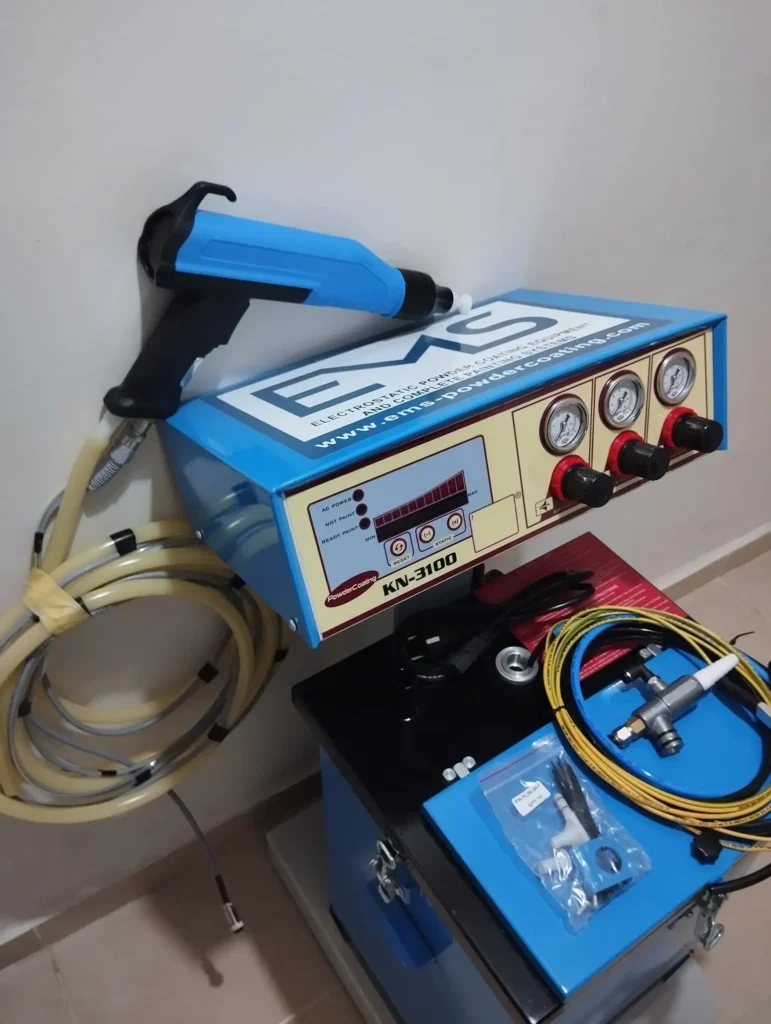
A budget powder coating gun is an affordable, entry-level tool designed for small-scale powder coating operations, DIY enthusiasts, or businesses looking to begin powder coating without a significant upfront investment. These powder coating guns offer a cost-effective solution for applying powder coatings to various metal parts, including automotive components, machinery, furniture, and more. While they may not offer the same advanced features or durability as professional-grade models, budget powder coating guns are ideal for hobbyists and small businesses that need a reliable, user-friendly tool for occasional use.
Budget powder coating guns typically operate using an electrostatic process, where the powder is charged and attracted to a grounded metal part. The powder is then cured in an oven, creating a durable and protective finish. In this section, we will explore the features, advantages, limitations, and best practices for using budget powder coating guns.
Key Features of a Budget Powder Coating Gun
- Electrostatic Charging Mechanism
Like professional powder coating guns, budget powder coating guns use an electrostatic process to apply powder to metal parts. The gun imparts a negative charge to the powder particles, which are then attracted to the positively grounded metal surface. This electrostatic attraction ensures that the powder adheres evenly to the part, reducing waste and improving coverage.- Voltage Settings: Many budget powder coating guns come with adjustable voltage settings, allowing the user to control the strength of the electrostatic charge. While lower-end models may have fixed voltage, more advanced budget models offer adjustable voltage to fine-tune the application process.
- Powder Flow Control
Budget powder coating guns typically include basic powder flow control features, allowing the user to adjust the amount of powder being sprayed. This helps to avoid over-spraying and ensures that the coating is applied evenly. While these controls may not be as precise as those on professional-grade guns, they are sufficient for small-scale and hobby applications. - Compact and Lightweight Design
Budget powder coating guns are often designed to be compact and lightweight, making them easy to handle and maneuver. This is particularly beneficial for users who are new to powder coating or for those working in small spaces. The lightweight design also reduces operator fatigue during extended use. - Interchangeable Nozzles
Some budget powder coating guns come with interchangeable nozzles that allow the user to change the spray pattern depending on the part being coated. Different nozzles can be used for fine, detailed work or for covering larger surfaces. This flexibility allows the user to adapt the spray gun to a variety of coating projects. - Powder Cup or Hopper
Budget powder coating guns typically feature a powder cup or hopper that holds the powder during application. While professional models may use larger hoppers for continuous production, budget models usually have smaller powder cups that are sufficient for small batches or DIY projects. These powder cups are easy to refill and clean, making them convenient for occasional use.
Advantages of a Budget Powder Coating Gun
- Cost-Effective Solution
One of the most significant advantages of a budget powder coating gun is its affordability. For small businesses, DIY enthusiasts, or those new to powder coating, a budget gun provides an entry point into powder coating without the high upfront costs associated with professional equipment. These guns are typically priced much lower than industrial models, making them accessible to users with limited budgets. - Easy to Use
Budget powder coating guns are designed to be user-friendly, with straightforward controls and simple setups. This makes them ideal for beginners who may be unfamiliar with the powder coating process. Many budget models come with basic instructions and require minimal training, allowing users to start coating parts quickly and efficiently. - Portable and Versatile
The compact and lightweight design of budget powder coating guns makes them highly portable and versatile. They can be used in small workshops, garages, or other spaces where professional-grade equipment may not be feasible. This portability allows users to coat parts in various locations and tackle a wide range of projects, from automotive components to household items. - Suitable for Small Projects
Budget powder coating guns are ideal for small-scale projects, custom jobs, or hobbyist applications. Whether coating a few automotive parts, refurbishing furniture, or working on DIY projects, these guns provide reliable performance for jobs that do not require industrial-grade output. They are well-suited for users who only need to powder coat occasionally or in small batches. - Compatible with Standard Powders
Most budget powder coating guns are compatible with standard thermoset and thermoplastic powders, giving users a wide range of color and finish options. This compatibility allows users to choose from various powder types and achieve high-quality finishes that are durable and long-lasting.
Limitations of a Budget Powder Coating Gun
- Limited Features
While budget powder coating guns are designed for affordability, they often lack the advanced features found in higher-end models. For example, budget guns may not offer precise control over powder flow, adjustable voltage, or advanced nozzles for intricate work. Users looking for more control over the powder application process may find these limitations restrictive, particularly for complex projects. - Lower Durability
Budget powder coating guns are typically made from lighter materials, which may not withstand heavy or prolonged use as well as professional-grade models. For occasional use, they perform well, but in high-volume production environments, their components may wear out faster, leading to more frequent repairs or replacements. - Limited Powder Capacity
The powder cups or hoppers on budget powder coating guns are generally smaller than those found on professional models. This means that users may need to refill the powder cup more frequently when working on larger projects, which can slow down production. Additionally, the smaller capacity may not be sufficient for large or continuous production runs. - Less Consistent Coverage
Budget powder coating guns may not provide the same level of coverage consistency as professional models, particularly when coating complex shapes or recessed areas. While they work well for straightforward projects, achieving complete and even coverage on intricate parts may require additional passes or touch-ups.
Best Practices for Using a Budget Powder Coating Gun
- Proper Surface Preparation
As with any powder coating project, proper surface preparation is essential for achieving a high-quality finish. Before applying the powder, the metal part should be cleaned thoroughly to remove any dirt, grease, rust, or other contaminants. Sandblasting, media blasting, or chemical cleaning may be necessary to ensure that the surface is free from oxidation or residue. Proper surface preparation ensures that the powder adheres correctly and forms a durable bond with the metal. - Adjust Powder Flow and Voltage
If the budget powder coating gun allows for adjustable powder flow and voltage, it’s important to fine-tune these settings based on the part being coated. A higher voltage can improve powder adhesion on large or flat surfaces, while a lower voltage may be more suitable for intricate parts. Adjusting the powder flow ensures that the right amount of powder is applied, reducing the risk of overspray or waste. - Ensure Consistent Grounding
To achieve even coverage, it’s essential to properly ground the metal part being coated. This ensures that the electrostatic charge attracts the powder evenly across the entire surface. A poor ground can result in uneven coverage, weak adhesion, or powder buildup in certain areas. Use a reliable grounding clip or fixture to ensure consistent results. - Use a Curing Oven
Once the powder has been applied, the part must be cured in a powder coating oven. Budget powder coating guns do not include curing capabilities, so users must invest in a curing oven that can reach the appropriate temperature (typically 350°F to 400°F) for the powder being used. Curing ensures that the powder melts, flows, and bonds to the surface of the metal, creating a smooth and durable finish. - Regular Maintenance
Perform regular maintenance on the powder coating gun, including cleaning the powder cup, spray nozzles, and electrostatic components. This helps prevent clogs or inconsistencies in the powder flow and ensures that the gun continues to perform reliably. Additionally, inspect the grounding system and replace any worn or damaged components to maintain optimal performance.
Applications of Budget Powder Coating Guns
- Automotive and Motorcycle Parts
Budget powder coating guns are frequently used by automotive enthusiasts to coat small parts such as wheels, valve covers, brackets, and suspension components. Powder coating provides a durable, corrosion-resistant finish that protects these parts from rust and wear while also enhancing their appearance. Budget guns offer an affordable way to achieve professional-looking results on DIY automotive projects. - Custom Furniture and Home Décor
Powder coating is a popular choice for refurbishing metal furniture, fixtures, and home décor items. Budget powder coating guns can be used to apply a variety of colors and finishes to items such as chairs, tables, light fixtures, and frames. The durable powder-coated finish resists chipping, scratching, and fading, making it ideal for both indoor and outdoor use. - Metal Fabrication and Repair
Small-scale metal fabricators and repair shops often use budget powder coating guns to apply protective coatings to fabricated parts or repaired components. Powder coating helps protect metal parts from corrosion and wear, while also providing a professional finish. Budget guns are well-suited for these applications, as they offer an affordable way to coat small batches of parts without the need for industrial-grade equipment. - DIY Projects and Hobbyist Applications
For hobbyists and DIY enthusiasts, budget powder coating guns are an excellent tool for personal projects. Whether restoring vintage car parts, customizing metal art, or creating one-of-a-kind metal goods, a budget powder coating gun provides a cost-effective way to achieve a durable and attractive finish. These guns are ideal for users who enjoy hands-on projects and want to experiment with powder coating without a significant investment.
Conclusion
Budget powder coating guns provide an affordable and accessible solution for small-scale powder coating projects, DIY enthusiasts, and hobbyists. While they may lack some of the advanced features and durability of professional-grade models, budget guns offer reliable performance for occasional use and small projects. With proper surface preparation, careful adjustment of powder flow and voltage, and regular maintenance, users can achieve high-quality, durable finishes that protect and enhance metal parts. Whether coating automotive components, refurbishing furniture, or working on DIY projects, budget powder coating guns offer a cost-effective way to enter the world of powder coating.
Cartridge Filter Powder Coating Booth

A cartridge filter powder coating booth is a specialized enclosure designed for the efficient and safe application of powder coatings in industrial and manufacturing environments. These booths are equipped with advanced filtration systems that use cartridge filters to capture and remove excess powder from the air, ensuring a clean and controlled environment during the coating process. Cartridge filter powder coating booths are widely used in industries such as automotive, aerospace, furniture manufacturing, and metal fabrication, where high-quality finishes and safety are critical.
The primary function of the cartridge filter system is to collect and filter out the overspray powder, preventing it from contaminating the workspace and allowing for the recovery and reuse of powder. This filtration system helps maintain air quality, protect workers, and reduce waste, making it a cost-effective and environmentally friendly solution for large-scale powder coating operations.
In this section, we will explore the features, benefits, and best practices for using a cartridge filter powder coating booth in industrial applications.
Components and Functionality of a Cartridge Filter Powder Coating Booth
A cartridge filter powder coating booth consists of several key components that work together to ensure efficient powder application and safe operation. These components include the booth enclosure, filtration system, powder recovery system, and airflow management system.
- Booth Enclosure
The booth enclosure is a sealed space where powder coating is applied to metal parts. It is designed to contain the overspray powder and ensure that the powder does not escape into the surrounding environment. The enclosure is typically made from metal panels or other durable materials that resist corrosion and are easy to clean. The interior of the booth may be equipped with lighting to improve visibility during the coating process.- Size and Configuration: Cartridge filter powder coating booths come in various sizes and configurations, depending on the size of the parts being coated and the production volume. Smaller booths may be designed for batch processing of individual parts, while larger booths can accommodate conveyorized systems for continuous coating of large volumes of parts.
- Cartridge Filtration System
The cartridge filtration system is the core of the powder coating booth. It uses cylindrical filters made from pleated filter media to capture the excess powder particles generated during the application process. As the powder-laden air is drawn into the filtration system, the cartridge filters trap the powder, allowing clean air to be recirculated back into the booth or exhausted from the facility.- Pleated Cartridge Filters: The pleated design of the cartridge filters increases the surface area available for filtration, improving the system’s efficiency and allowing it to capture a higher volume of powder. The filters are made from materials that resist clogging and can be cleaned and reused multiple times before needing to be replaced.
- Pulse Jet Cleaning: Many cartridge filter systems are equipped with a pulse jet cleaning mechanism that uses bursts of compressed air to remove powder buildup from the filter media. This self-cleaning feature ensures that the filters maintain optimal performance and prevents powder from clogging the filtration system.
- Powder Recovery System
The powder recovery system collects the powder captured by the filtration system and recycles it for reuse. Excess powder that does not adhere to the part is drawn into the filters, and once filtered, it can be returned to the powder supply hopper for reuse. This powder recovery system significantly reduces powder waste and lowers the overall cost of powder coating by allowing businesses to reuse powder rather than disposing of it.- Powder Hopper: The recovered powder is stored in a hopper, where it can be mixed with fresh powder and reused in subsequent coating applications. This helps ensure that businesses can maximize their powder usage and minimize waste.
- Cyclone Separator (Optional): Some cartridge filter powder coating booths are equipped with a cyclone separator, which further improves the efficiency of powder recovery by separating larger powder particles from the air before it reaches the cartridge filters. The cyclone separator reduces the load on the filters and increases their lifespan.
- Airflow Management System
Proper airflow management is essential for ensuring that the powder is applied evenly and that the overspray is captured effectively by the filtration system. The booth’s airflow system is designed to create a controlled environment where the powder can be applied without turbulence or disruptions that could affect the quality of the finish.- Exhaust Fans: The booth is equipped with exhaust fans that create negative pressure inside the enclosure, drawing the powder-laden air toward the filtration system. These fans ensure that the powder is captured efficiently and that the air inside the booth remains clean.
- Air Circulation: In some systems, clean air is recirculated back into the booth after passing through the cartridge filters, helping to maintain a consistent airflow and prevent powder buildup in the booth.
Benefits of a Cartridge Filter Powder Coating Booth
- Improved Air Quality and Worker Safety
The cartridge filtration system in a powder coating booth effectively captures and removes excess powder from the air, preventing it from contaminating the workspace or being inhaled by workers. This ensures that the air quality in the facility remains safe and compliant with environmental and occupational health standards. By reducing the amount of airborne powder, the system also minimizes the risk of respiratory issues or powder-related accidents. - Efficient Powder Recovery and Cost Savings
One of the key advantages of a cartridge filter powder coating booth is its ability to recover and reuse excess powder. The filtration system captures powder that does not adhere to the part, allowing it to be recycled for future use. This reduces powder waste and significantly lowers material costs, making the system highly cost-effective for large-scale powder coating operations. - Consistent and High-Quality Finishes
Proper airflow management and efficient powder capture ensure that the powder is applied evenly to the part, resulting in a smooth and uniform finish. The controlled environment of the booth prevents powder contamination or turbulence that could lead to defects such as uneven coating, orange peel, or overspray. This consistency is critical for achieving high-quality finishes that meet industry standards. - Low Maintenance and Longevity
Cartridge filter systems are designed for durability and long-term use. The pleated filters can be cleaned and reused multiple times, reducing the need for frequent replacements. Additionally, the pulse jet cleaning system ensures that the filters remain free from clogs, maintaining optimal performance over time. This low-maintenance design reduces downtime and operating costs, allowing businesses to focus on production. - Environmentally Friendly Operation
By capturing and recycling powder, cartridge filter powder coating booths help reduce waste and minimize the environmental impact of the powder coating process. The system’s ability to reuse powder not only lowers material costs but also reduces the amount of powder that needs to be disposed of, making it a more sustainable option compared to other coating methods.
Applications of Cartridge Filter Powder Coating Booths
- Automotive Industry
Cartridge filter powder coating booths are widely used in the automotive industry for coating parts such as wheels, suspension components, frames, and body panels. The booths ensure that the powder is applied evenly and consistently, resulting in a durable finish that protects the part from corrosion, wear, and environmental exposure. The ability to recover and reuse powder is particularly valuable in the automotive industry, where large volumes of parts are coated daily. - Aerospace Industry
In the aerospace industry, powder coating booths are used to apply protective coatings to aluminum and steel components. These coatings provide corrosion resistance and enhance the durability of parts that are exposed to harsh environmental conditions, such as aircraft fuselage panels, landing gear, and engine components. The controlled environment of the booth ensures that the powder coating meets the strict quality and safety standards required in aerospace applications. - Furniture and Consumer Goods Manufacturing
Cartridge filter powder coating booths are commonly used in the production of metal furniture, lighting fixtures, and consumer goods. Powder coating provides a durable, attractive finish that enhances the appearance and performance of metal products. The filtration system ensures that the powder is applied evenly, resulting in a smooth, high-quality finish that is resistant to chipping, scratching, and fading. - Metal Fabrication and Industrial Equipment
In metal fabrication and industrial equipment manufacturing, powder coating booths are used to apply protective coatings to fabricated parts and machinery. These coatings provide corrosion resistance and mechanical protection, ensuring that the parts can withstand the demanding conditions of industrial environments. The powder recovery system helps reduce material costs, making the process more efficient for high-volume production.
Challenges of Cartridge Filter Powder Coating Booths
- Initial Investment Cost
While cartridge filter powder coating booths offer long-term cost savings through powder recovery and efficient operation, the initial investment cost can be significant. The purchase and installation of the booth, along with the necessary ventilation and filtration systems, require upfront capital. However, for businesses that rely on powder coating as a key part of their production process, the long-term benefits often outweigh the initial expense. - Filter Maintenance and Replacement
Although the cartridge filters are designed to be durable and reusable, they do require regular maintenance to ensure optimal performance. Over time, the filters can become clogged with powder, reducing airflow and filtration efficiency. The pulse jet cleaning system helps extend the life of the filters, but eventually, the filters will need to be replaced. Businesses must factor in the cost of replacement filters and the time required for maintenance. - Space Requirements
Cartridge filter powder coating booths require sufficient space for installation, including the booth enclosure, filtration system, and ventilation equipment. For businesses with limited space, finding room for the booth and ensuring proper airflow can be a challenge. Careful planning and facility layout are essential to ensure that the booth can be integrated into the production process without disrupting other operations. - Energy Consumption
The fans and filtration system in a powder coating booth require energy to operate, particularly in high-volume production environments. Businesses must monitor energy consumption and implement energy-saving practices where possible to reduce operating costs. Choosing energy-efficient equipment, such as low-energy fans or variable-speed blowers, can help mitigate the impact of energy usage.
Best Practices for Using a Cartridge Filter Powder Coating Booth
- Regular Maintenance of Filters and Equipment
Perform regular maintenance on the cartridge filters, pulse jet cleaning system, and exhaust fans to ensure that the booth operates efficiently. Clean the filters regularly to prevent powder buildup and replace filters as needed to maintain optimal airflow and filtration performance. Proper maintenance extends the life of the equipment and reduces the risk of downtime. - Optimize Airflow and Powder Recovery
Ensure that the booth’s airflow system is properly calibrated to create a controlled environment for powder application. Check the exhaust fans and air circulation system regularly to prevent turbulence or disruptions in the booth. Additionally, monitor the powder recovery system to ensure that excess powder is being collected and recycled efficiently, reducing waste and material costs. - Use High-Quality Powder Coatings
Select high-quality powder coatings that are compatible with the booth’s filtration and recovery system. Quality powders provide better coverage, adhesion, and durability, reducing the likelihood of defects or rework. Using high-quality powders also improves the efficiency of the recovery system, as less powder is wasted during the application process. - Train Operators on Proper Booth Use
Provide comprehensive training for operators to ensure that they understand how to use the powder coating booth and filtration system correctly. Proper training helps prevent common issues such as uneven coating, overspray, or equipment malfunctions. Operators should be trained on how to monitor the airflow, adjust the powder flow, and perform routine maintenance on the filters and booth components.
Conclusion
A cartridge filter powder coating booth is an essential tool for achieving high-quality, consistent powder-coated finishes in industrial applications. The advanced filtration system captures and recovers excess powder, improving air quality, reducing waste, and lowering material costs. By providing a controlled environment for powder application, the booth ensures that coatings are applied evenly and efficiently, resulting in durable, corrosion-resistant finishes that meet industry standards.
While the initial investment cost may be high, the long-term benefits of powder recovery, improved worker safety, and reduced maintenance make cartridge filter powder coating booths a valuable asset for businesses in the automotive, aerospace, furniture, and metal fabrication industries. By following best practices for maintenance, airflow optimization, and operator training, businesses can maximize the performance and efficiency of their powder coating booths.
Paint Spray and Coatings Systems

Paint spray and coatings systems are essential tools for applying protective and decorative finishes to various surfaces in industrial, automotive, architectural, and consumer goods sectors. These systems allow for the efficient and uniform application of liquid paints, primers, and other coatings, ensuring a smooth, high-quality finish that enhances both the appearance and durability of the coated surface. Modern paint spray and coatings systems are designed for precision, speed, and efficiency, making them an indispensable part of many production and finishing processes.
From airless spray guns to automated coating lines, paint spray systems come in a variety of configurations to meet the specific needs of different industries. Whether for painting automotive parts, protecting metal surfaces from corrosion, or applying decorative finishes to consumer goods, paint spray and coatings systems offer flexibility and consistency in coating applications.
This section will explore the types of paint spray and coatings systems, their components, benefits, and best practices for achieving optimal results in different industrial applications.
Types of Paint Spray and Coatings Systems
- Airless Paint Spray Systems
Airless paint spray systems use high pressure to force paint through a small orifice in the spray gun, atomizing the paint into a fine mist. Unlike conventional air spray systems, airless systems do not use compressed air to atomize the paint, making them more efficient and less prone to overspray. Airless paint spray systems are ideal for large surface areas, high-viscosity coatings, and thick layers of paint or protective coatings.- Advantages:
- Reduces overspray and waste.
- Can apply high-viscosity coatings.
- Suitable for large surface areas and outdoor projects.
- Provides even coverage with fewer coats.
- Disadvantages:
- Requires higher pressure, which can be harder to control for fine or intricate work.
- May not be suitable for thin or detailed coatings.
- Advantages:
- HVLP (High Volume Low Pressure) Systems
HVLP spray systems use a high volume of air at low pressure to atomize the paint and create a fine, even spray pattern. This system is popular for precision work, such as automotive detailing or furniture finishing, where a smooth, even finish is required. HVLP systems are highly efficient in transferring paint to the surface, minimizing waste and overspray, and providing better control over the spray pattern.- Advantages:
- High transfer efficiency with minimal overspray.
- Excellent control for detailed or intricate work.
- Produces a smooth, even finish.
- Ideal for low-viscosity coatings like stains and varnishes.
- Disadvantages:
- Slower application rate compared to airless systems.
- Not suitable for high-viscosity coatings or large surfaces.
- Advantages:
- Electrostatic Spray Systems
Electrostatic spray systems use an electrostatic charge to attract the paint particles to the surface being coated. This process ensures even coverage and reduces waste by ensuring that the paint adheres more efficiently to the surface. Electrostatic systems are commonly used in industrial settings for coating metal parts, such as automotive components or appliances, as they provide excellent coverage and reduce the amount of paint required.- Advantages:
- High transfer efficiency, reducing paint waste.
- Provides uniform coverage, even on complex shapes.
- Reduces the amount of paint needed for a complete finish.
- Disadvantages:
- Requires careful grounding of the object being coated.
- May not be suitable for all types of surfaces, particularly non-conductive materials.
- Advantages:
- Air-Assisted Airless Systems
Air-assisted airless systems combine the high-pressure delivery of airless systems with the fine atomization of air spray. These systems are designed for applications that require both speed and precision, such as finishing metal, wood, or plastic components. Air-assisted airless systems provide better control over the spray pattern than traditional airless systems, while still offering the ability to apply thicker coatings.- Advantages:
- Combines speed with precision, ideal for high-volume production.
- Provides a smoother finish than traditional airless systems.
- Can handle a wide range of coating viscosities.
- Disadvantages:
- More complex setup and operation compared to other systems.
- Requires fine-tuning for optimal results.
- Advantages:
- Automated Coating Systems
Automated paint spray systems are used in high-volume production environments where consistent, repeatable results are required. These systems use robotic arms, conveyors, or automated sprayers to apply coatings to parts in a controlled, automated process. Automated systems are ideal for industries such as automotive manufacturing, where uniformity, speed, and precision are critical.- Advantages:
- Consistent, repeatable results with minimal variation.
- Increases production efficiency and reduces labor costs.
- Ideal for large-scale production with high throughput.
- Can be integrated with other manufacturing processes for seamless operation.
- Disadvantages:
- High initial investment and complex setup.
- Requires regular maintenance and calibration.
- Advantages:
Key Components of Paint Spray and Coatings Systems
- Spray Gun
The spray gun is the most critical component of any paint spray system. It atomizes the paint and directs it onto the surface being coated. Depending on the type of system, the spray gun may use air, electrostatic charges, or high pressure to achieve the desired spray pattern. Spray guns can be handheld for manual operation or mounted on robotic arms for automated systems.- Nozzle: The size of the nozzle determines the flow rate and spray pattern of the paint. Nozzles can be adjusted or swapped out to accommodate different types of coatings or surface areas.
- Trigger: The trigger controls the flow of paint through the gun. Some systems feature adjustable triggers that allow the operator to fine-tune the paint flow during application.
- Pump
In systems such as airless or air-assisted airless spray systems, a pump is used to pressurize the paint and force it through the spray gun. The pump must be powerful enough to handle the viscosity of the coating being applied while maintaining consistent pressure for even application. - Compressor
For HVLP and conventional air spray systems, a compressor provides the air needed to atomize the paint. The compressor must deliver sufficient air volume and pressure to achieve the desired spray pattern and finish. In large industrial applications, the compressor may be part of a centralized air system that serves multiple spray guns or workstations. - Air Filters and Regulators
Air filters and regulators are used to ensure that the air supply is clean and free from contaminants such as dust, oil, or moisture, which could affect the quality of the finish. Regulators control the air pressure to ensure that it remains consistent throughout the coating process, preventing variations in the spray pattern or finish. - Hoses and Fluid Lines
Hoses and fluid lines carry the paint or coating from the pump or reservoir to the spray gun. These lines must be compatible with the type of paint being used and should be inspected regularly for leaks or damage. In electrostatic spray systems, special conductive hoses are used to carry the electrostatically charged paint. - Paint Reservoir or Hopper
The paint reservoir, tank, or hopper stores the paint or coating material during the application process. For smaller systems, this may be a small cup attached to the spray gun. In larger systems, the paint is stored in a pressurized tank or hopper, allowing for continuous operation without the need for frequent refilling.
Benefits of Paint Spray and Coatings Systems
- Efficient and Uniform Coverage
Paint spray systems provide efficient and uniform coverage, ensuring that the paint or coating is applied evenly across the surface. This is especially important for achieving a high-quality finish that is free from streaks, runs, or uneven thickness. Automated systems, in particular, can apply coatings with a high degree of consistency, reducing the need for touch-ups or rework. - Time and Labor Savings
Paint spray systems are significantly faster than manual painting methods, such as brushing or rolling. This allows for faster production cycles and reduces labor costs. Automated systems further increase efficiency by eliminating the need for manual intervention, allowing for continuous, high-volume production. - Reduced Waste and Overspray
Modern paint spray systems, such as HVLP and electrostatic systems, are designed to minimize overspray and reduce paint waste. This not only helps reduce material costs but also ensures a cleaner, safer work environment by preventing excess paint from contaminating the surrounding area. - Versatility Across Applications
Paint spray systems can be used to apply a wide range of coatings, including paints, primers, varnishes, lacquers, and protective coatings. This versatility makes them suitable for a variety of industries, including automotive, aerospace, metal fabrication, and consumer goods manufacturing. The ability to adjust the spray pattern, flow rate, and pressure ensures that the system can handle coatings of different viscosities and formulations. - Improved Finish Quality
The fine atomization provided by spray systems ensures that coatings are applied smoothly and evenly, resulting in a high-quality finish with a professional appearance. This is particularly important for applications where the aesthetic quality of the finish is critical, such as automotive detailing, furniture manufacturing, or high-end consumer goods.
Challenges of Paint Spray and Coatings Systems
- Initial Investment Cost
Paint spray and coatings systems, particularly automated or air-assisted systems, can require a significant upfront investment. The cost of purchasing and installing the necessary equipment, such as spray guns, pumps, compressors, and filtration systems, may be prohibitive for smaller businesses or those just starting out. However, the long-term benefits of improved efficiency and reduced waste often justify the initial cost. - Maintenance and Calibration
Regular maintenance is essential to ensure that paint spray systems operate efficiently and produce high-quality finishes. This includes cleaning the spray gun, checking hoses for leaks, replacing worn nozzles, and calibrating the equipment to ensure consistent performance. Automated systems, in particular, require regular calibration and monitoring to ensure that the robotic arms or conveyors are functioning correctly. - Skill and Training Requirements
While automated systems can reduce the need for manual labor, operating paint spray systems still requires skill and training. Operators must understand how to adjust the settings, select the appropriate nozzle size, and troubleshoot any issues that arise during the coating process. Proper training ensures that the system is used safely and effectively. - Environmental Considerations
Paint spray systems can produce airborne particles, fumes, and volatile organic compounds (VOCs), which can be harmful to both workers and the environment. Businesses must implement proper ventilation and air filtration systems to capture and filter out these contaminants, ensuring a safe work environment and compliance with environmental regulations. Some systems, such as electrostatic and HVLP sprayers, are designed to reduce emissions and waste, but proper safety measures are still essential.
Best Practices for Using Paint Spray and Coatings Systems
- Ensure Proper Surface Preparation
Surface preparation is critical to achieving a high-quality finish with paint spray systems. Before applying the coating, the surface must be thoroughly cleaned to remove dirt, grease, rust, or other contaminants. Sandblasting, media blasting, or chemical cleaning may be necessary to ensure that the surface is ready to accept the coating. Proper surface preparation helps improve adhesion and ensures a smooth, long-lasting finish. - Optimize Spray Settings
Adjust the spray gun’s settings, including the pressure, flow rate, and nozzle size, to match the type of coating being applied and the surface being coated. Using the correct settings ensures that the paint is atomized evenly and applied with the appropriate thickness, reducing the risk of defects such as runs, drips, or uneven coverage. - Use High-Quality Coatings
Select high-quality paints, primers, and coatings that are compatible with the spray system and the surface being coated. Quality coatings provide better adhesion, durability, and appearance, reducing the likelihood of defects or rework. Using high-quality coatings also improves transfer efficiency, reducing waste and overspray. - Maintain and Clean Equipment Regularly
Regular maintenance and cleaning of the spray gun, pumps, hoses, and compressors are essential for ensuring consistent performance and prolonging the life of the equipment. After each use, clean the spray gun thoroughly to prevent clogs or buildup that could affect future coatings. Check for wear on nozzles and hoses and replace them as needed to ensure optimal performance. - Implement Proper Ventilation and Safety Measures
Ensure that the workspace is well-ventilated and that proper safety measures are in place to protect workers from fumes, overspray, and airborne particles. Use respirators, protective clothing, and other safety equipment as necessary, and install air filtration systems to capture VOCs and other contaminants. Following these safety guidelines helps maintain a safe work environment and ensures compliance with industry regulations.
Conclusion
Paint spray and coatings systems are essential tools for applying high-quality, consistent finishes in a variety of industries. From airless spray systems for large-scale projects to HVLP sprayers for detailed work, these systems offer flexibility, efficiency, and precision in coating applications. By following best practices for surface preparation, equipment maintenance, and safety, businesses can achieve optimal results with their paint spray systems, ensuring durable, attractive finishes that meet industry standards. Whether used in automotive manufacturing, metal fabrication, or consumer goods production, paint spray and coatings systems play a crucial role in enhancing the appearance and performance of coated products.
Powder coating technology represents a significant evolution in the field of industrial coating processes. Unlike traditional liquid coatings, which rely on solvent-based applications, powder coating uses finely ground particles of resin and pigment, electrostatically charged and sprayed onto a surface. The result is a uniform, high-quality finish that offers enhanced durability, corrosion resistance, and aesthetic appeal.
Powder coating has gained widespread acceptance across various industries, including automotive, aerospace, appliances, and architecture, due to its environmentally friendly properties. The absence of harmful volatile organic compounds (VOCs) makes powder coating a preferred choice for companies seeking sustainable manufacturing practices. Additionally, the efficient application process ensures minimal waste, as any overspray can be collected and reused.
At its core, powder coating technology involves four key stages:
- Surface Preparation – Cleaning and treating the surface to ensure proper adhesion of the powder.
- Powder Application – Electrostatically applying the powder particles to the surface.
- Curing Process – Heating the coated object in an oven to fuse the powder into a smooth, durable layer.
- Final Inspection – Quality control measures to ensure the coating meets industry standards.
Each of these steps is supported by specialized equipment designed to enhance precision, consistency, and efficiency. In the following sections, we will delve into the specifics of the equipment, tools, and systems essential for a high-quality powder coating operation.
To create a long formal text with detailed sections of approximately 1,000 words each for a professional website, I will focus on providing in-depth information on each keyword. The tone will remain technical and informative, suitable for industry professionals or businesses looking for solutions related to powder coating systems and equipment.
A critical stage in the powder coating process is the curing phase, where the applied powder undergoes a transformation from a dry state to a durable, smooth finish. This process requires high, consistent temperatures, and the equipment used for this is known as a powder coating oven. While there are various types of ovens based on fuel sources, diesel powder coating ovens stand out for their ability to handle heavy-duty industrial workloads, particularly in environments where other fuel sources like gas or electricity may not be feasible.
Diesel powder coating ovens offer reliable, efficient heating, making them an ideal choice for large-scale manufacturing operations or locations where diesel is readily available and cost-effective. These ovens are engineered to deliver the precise temperature control required for curing powder coatings on metal, aluminum, and other materials, ensuring that the coating bonds securely to the surface and provides maximum durability.
EMS Powder Coating Equipment is a leader in manufacturing high-quality diesel-powered curing ovens that are designed for efficiency, durability, and superior performance. EMS ovens are built to meet the rigorous demands of industrial production lines, offering businesses a reliable solution for curing powder-coated products. In this guide, we will explore how diesel powder coating ovens work, their benefits, and why EMS Powder Coating Equipment is the best option for businesses in need of high-performance curing ovens.
What is a Diesel Powder Coating Oven?
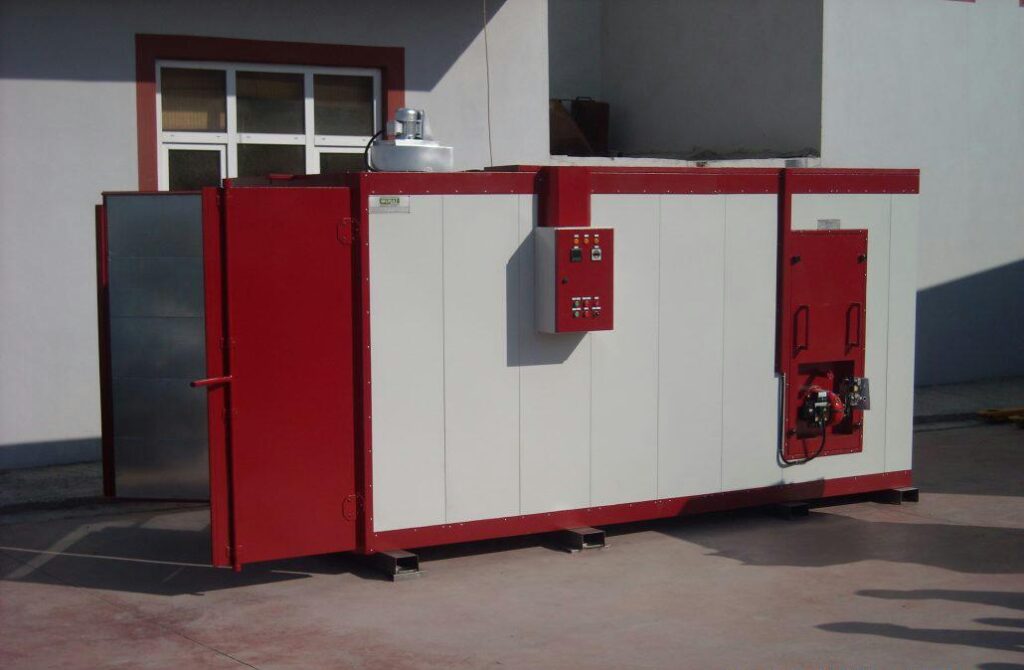
A diesel powder coating oven is a specialized curing oven that uses diesel fuel as its primary source of energy to generate heat. These ovens are specifically designed for curing powder-coated products, where the applied powder needs to be heated to a specific temperature to melt, flow, and chemically bond to the substrate. Once cured, the powder forms a hard, smooth, and durable finish that is resistant to corrosion, wear, and environmental factors.
Diesel powder coating ovens are typically used in industrial settings where electricity or natural gas may not be the most cost-effective or practical option. They are particularly advantageous in regions where diesel fuel is readily available or more affordable than other energy sources. These ovens are built to handle large workloads, making them suitable for high-volume production environments.
How Diesel Ovens Work

In a diesel powder coating oven, diesel fuel is burned in a combustion chamber, generating heat that is then transferred to the curing chamber where the powder-coated products are placed. The oven is equipped with a sophisticated ventilation system that ensures consistent air circulation, distributing heat evenly throughout the chamber. This uniform heating is crucial to achieving a consistent, high-quality finish across all products.
Most diesel ovens are equipped with digital control systems that allow operators to set and monitor the temperature and curing time. This level of control ensures that the powder reaches its optimal curing temperature, usually between 160°C and 220°C (320°F to 428°F), depending on the type of powder being used.
EMS Powder Coating Equipment manufactures diesel ovens that offer precise temperature control and efficient fuel consumption. Their ovens are designed with advanced insulation and heat recovery systems to minimize fuel usage while maintaining consistent curing temperatures, making them an excellent choice for businesses looking to reduce operational costs without sacrificing performance.
The Benefits of Diesel Powder Coating Ovens

Diesel powder coating ovens offer several advantages that make them an attractive option for businesses operating in industrial environments. Here are some of the key benefits of using diesel ovens for your powder coating operations:
1. Reliable and Consistent Heat
One of the main advantages of diesel powder coating ovens is their ability to provide consistent, reliable heat over long periods. Diesel combustion generates a steady and powerful heat source, making these ovens ideal for curing large volumes of products. Consistent heat is critical in the powder coating process, as uneven heating can result in an inconsistent finish or cause defects such as bubbling or peeling.
Diesel ovens are designed to maintain a uniform temperature throughout the curing chamber, ensuring that every part of the product is exposed to the same heat conditions. This results in a smooth, durable finish that meets industry standards for quality and performance.
EMS Powder Coating Equipment manufactures diesel ovens with advanced temperature control systems that ensure even heat distribution across the entire oven. Their ovens are engineered to deliver consistent curing results, making them ideal for businesses that demand high-quality finishes on every product.
2. Cost-Effectiveness in Certain Regions
In regions where diesel fuel is more readily available or less expensive than natural gas or electricity, diesel ovens can offer significant cost savings. Businesses that operate in remote locations or areas with limited access to other energy sources can benefit from the affordability and availability of diesel fuel.
Additionally, diesel ovens are often more cost-effective to run in areas where the infrastructure for natural gas is not well-developed. For manufacturers in these regions, diesel powder coating ovens provide a practical, reliable solution for curing products without the need for expensive infrastructure upgrades.
EMS Powder Coating Equipment understands the varying needs of businesses around the world and provides diesel ovens that are both fuel-efficient and cost-effective. Their ovens are designed to optimize fuel consumption, ensuring that businesses can keep their operational costs low while maintaining high production output.
3. High-Volume Production Capability
Diesel powder coating ovens are often larger and more powerful than their electric or gas counterparts, making them well-suited for high-volume production environments. These ovens are capable of handling large batches of products, which is essential for industries such as automotive manufacturing, metal fabrication, and industrial equipment production.
High-volume production environments require ovens that can maintain consistent curing temperatures while accommodating large workloads. Diesel ovens excel in this regard, as they are designed to deliver the high levels of heat necessary to cure powder coatings quickly and efficiently.
EMS Powder Coating Equipment specializes in diesel ovens that are built for large-scale production. Their ovens can handle a wide range of product sizes and shapes, ensuring that businesses can meet their production goals without sacrificing quality.
4. Durability and Longevity
Diesel ovens are known for their robust construction and ability to withstand the rigors of continuous industrial use. Built with high-quality materials and advanced engineering, diesel ovens are designed to last for many years with minimal maintenance. This durability is especially important in industries where equipment downtime can result in costly delays and lost productivity.
EMS Powder Coating Equipment builds its diesel ovens with durability in mind. Their ovens are constructed from high-grade materials that resist wear and tear, even under the most demanding conditions. EMS ovens are also designed with ease of maintenance in mind, ensuring that businesses can keep their equipment in top working condition with minimal effort.
5. Versatility Across Different Industries
Diesel powder coating ovens are versatile and can be used across a wide range of industries. From automotive and aerospace to metal fabrication and consumer goods, these ovens can cure a variety of products, including metal parts, machinery components, and outdoor furniture. The high heat output and large capacity of diesel ovens make them suitable for industries that require both performance and flexibility in their curing processes.
EMS Powder Coating Equipment offers customizable diesel ovens that can be tailored to the specific needs of different industries. Whether you need an oven for coating large metal structures or smaller components, EMS provides solutions that ensure optimal performance for your particular application.
6. Environmentally Friendly Options
While diesel fuel may not seem like the most environmentally friendly option, modern diesel ovens are designed to minimize emissions and improve fuel efficiency. Many diesel ovens are equipped with advanced burners and exhaust systems that reduce the amount of particulate matter and pollutants released into the atmosphere. Additionally, efficient fuel use reduces the overall carbon footprint of the curing process.
EMS Powder Coating Equipment is committed to sustainability and offers diesel ovens with energy-efficient features that help businesses minimize their environmental impact. Their ovens are designed to optimize fuel consumption and reduce emissions, making them a more eco-friendly option for businesses that need to use diesel-powered equipment.
Why Choose EMS Powder Coating Equipment for Diesel Ovens?
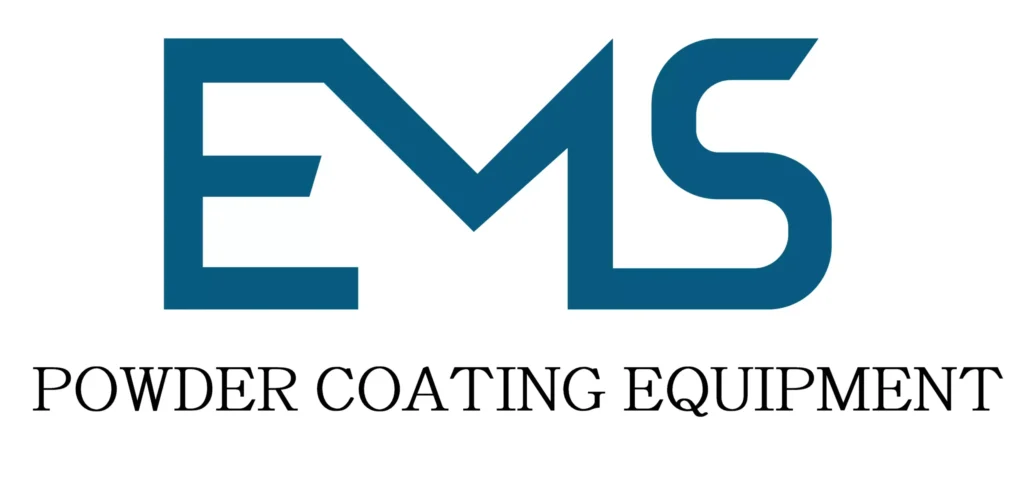
When selecting a diesel powder coating oven, businesses need a solution that offers reliability, efficiency, and long-lasting performance. EMS Powder Coating Equipment is recognized as a leader in the industry, providing diesel ovens that are tailored to meet the needs of high-demand industrial operations. Here’s why EMS is the best choice for businesses seeking top-quality diesel powder coating ovens:
1. Advanced Technology for Precision Control
EMS diesel ovens are equipped with advanced digital control systems that allow operators to set and monitor temperature and curing times with precision. This level of control ensures that the powder coating is cured at the exact temperature required, resulting in a durable, high-quality finish every time.
2. Customization for Specific Needs
Every business has unique requirements, and EMS Powder Coating Equipment understands the importance of providing customized solutions. EMS offers diesel ovens in a variety of sizes and configurations, allowing businesses to choose the oven that best fits their production needs. Whether you need an oven for small batches or large-scale production, EMS can provide a tailored solution.
3. Energy Efficiency and Cost Savings
EMS diesel ovens are designed with fuel efficiency in mind, helping businesses reduce their operating costs while maintaining consistent performance. Their ovens use advanced insulation and heat recovery systems to ensure that as much energy as possible is used for curing, minimizing fuel wastage and lowering overall energy consumption.
4. Built to Last
EMS Powder Coating Equipment is known for manufacturing ovens that are built to withstand the demands of continuous industrial use. Their diesel ovens are constructed from high-quality materials that ensure durability and longevity, allowing businesses to rely on their equipment for years to come.
5. Excellent Customer Support and Service
In addition to providing top-tier equipment, EMS offers outstanding customer support and after-sales service. From the initial consultation to installation and maintenance, EMS’s team of experts is dedicated to ensuring that your diesel oven performs at its best. Whether you need assistance with setup, troubleshooting, or routine maintenance, EMS is there to help.
Conclusion
Diesel powder coating ovens are a powerful, reliable solution for businesses that require consistent, high-quality curing in large-scale production environments. With their ability to deliver uniform heat, handle high volumes, and offer cost-effective fuel options, diesel ovens are an excellent choice for industries ranging from automotive to metal fabrication.
EMS Powder Coating Equipment is the industry leader in providing advanced diesel-powered ovens that are engineered for performance, durability, and efficiency. Whether you’re looking to upgrade your current system or invest in new equipment, EMS offers customizable solutions that ensure your powder coating operations are optimized for maximum productivity and quality.
By choosing EMS diesel powder coating ovens, businesses can improve their production efficiency, reduce operating costs, and achieve superior results in their powder coating processes. With a commitment to innovation and customer satisfaction, EMS is the best choice for businesses seeking reliable and efficient diesel ovens.
Electric Powder Coating Ovens: Efficient and Precise Curing for Modern Manufacturing

Powder coating is an essential finishing process for numerous industries, offering a durable, long-lasting coating that enhances the appearance and performance of products. A key component of this process is the curing stage, where the applied powder is heated to its melting point, allowing it to flow and bond to the substrate. The oven used during this stage is critical to achieving the desired coating properties, and in recent years, electric powder coating ovens have become increasingly popular due to their precision, energy efficiency, and ease of operation.
Electric powder coating ovens use electricity to generate the consistent, high temperatures needed to cure powder coatings effectively. These ovens are highly regarded for their ability to provide precise temperature control, making them ideal for industries that require consistent, high-quality finishes. With lower emissions and more stable energy costs, electric ovens are an attractive option for businesses looking to balance performance with environmental responsibility.
EMS Powder Coating Equipment is a leading manufacturer of electric powder coating ovens, providing advanced solutions designed to meet the needs of modern manufacturing. Known for their precision, energy efficiency, and reliable performance, EMS electric ovens are the preferred choice for businesses seeking to optimize their powder coating process. In this guide, we will explore how electric powder coating ovens work, their benefits, and why EMS Powder Coating Equipment is the best choice for businesses looking to invest in high-quality curing ovens.
What is an Electric Powder Coating Oven?

An electric powder coating oven is a specialized oven used to cure powder-coated products by heating them to a specific temperature, allowing the powder to melt and flow over the surface of the substrate. Unlike gas or diesel ovens, electric ovens use electricity as their energy source to generate heat, which is distributed evenly throughout the oven chamber via electric heating elements.
Electric powder coating ovens are designed to maintain consistent temperatures throughout the curing process, typically ranging between 160°C and 220°C (320°F to 428°F). This uniform heating ensures that the powder coating is applied evenly and bonds securely to the product’s surface, resulting in a smooth, durable finish.
How Electric Ovens Work
Electric ovens operate by using resistive heating elements that convert electrical energy into heat. These heating elements are strategically placed around the oven chamber to ensure even heat distribution. The heat is transferred to the air inside the chamber, which is circulated by fans to maintain a uniform temperature. Digital controllers allow operators to set the desired temperature and curing time, providing precise control over the entire process.
Electric ovens are available in various sizes and configurations, from small batch ovens used in workshops to large conveyorized systems for high-volume production lines. They are suitable for curing a wide range of powder-coated products, including metal parts, automotive components, furniture, and household appliances.
EMS Powder Coating Equipment offers a range of electric ovens designed to meet the specific needs of different industries. Their ovens are engineered for precision, with advanced controls that ensure accurate temperature regulation and consistent performance, even in demanding industrial environments.
The Benefits of Electric Powder Coating Ovens
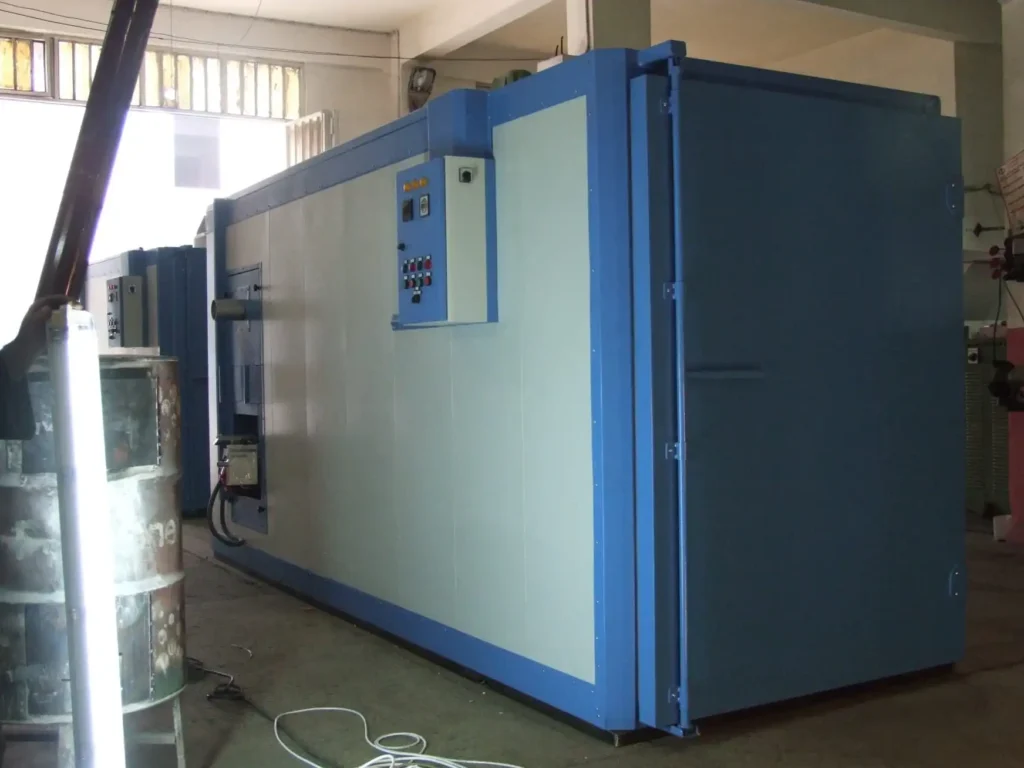
Electric powder coating ovens offer several advantages over other types of ovens, making them a popular choice for manufacturers looking to enhance the efficiency and quality of their powder coating process. Below are some of the key benefits of using electric ovens:
1. Precise Temperature Control
One of the standout benefits of electric powder coating ovens is their ability to provide highly precise temperature control. Electric heating elements respond quickly to changes in temperature, allowing operators to maintain a consistent heat level throughout the curing process. This precision is critical in ensuring that the powder coating cures properly, resulting in a smooth, durable finish.
Unlike gas or diesel ovens, which can experience fluctuations in temperature, electric ovens offer stable, uniform heating. This consistent heat distribution helps prevent issues such as uneven curing, blistering, or chipping, ensuring that every product meets strict quality standards.
EMS Powder Coating Equipment designs its electric ovens with advanced temperature controls, allowing businesses to fine-tune their curing process for optimal results. With EMS ovens, manufacturers can achieve uniform coatings on even the most complex products, ensuring high-quality finishes with every batch.
2. Energy Efficiency
Electric powder coating ovens are known for their energy efficiency, making them a cost-effective option for businesses seeking to reduce their energy consumption. Modern electric ovens are designed to use electricity efficiently, converting a high percentage of the electrical energy into usable heat. This efficiency translates into lower operating costs, especially for businesses that operate their ovens continuously or on a large scale.
Additionally, the energy costs associated with electricity tend to be more stable than those of natural gas or diesel, allowing businesses to predict and manage their operating expenses more effectively. Electric ovens also feature advanced insulation and heat recovery systems that minimize heat loss, further enhancing their energy efficiency.
EMS Powder Coating Equipment prioritizes energy efficiency in the design of their electric ovens. Their ovens are equipped with state-of-the-art insulation and energy-saving technologies that help businesses lower their energy consumption while maintaining excellent curing performance.
3. Cleaner Operation and Lower Emissions
Electric powder coating ovens offer a cleaner and more environmentally friendly alternative to gas or diesel ovens. Since electric ovens do not rely on combustion, they produce no direct emissions, reducing the overall environmental impact of the curing process. This makes electric ovens particularly attractive for businesses looking to minimize their carbon footprint and comply with environmental regulations.
Additionally, the absence of combustion byproducts means that electric ovens maintain a cleaner working environment. There is no risk of introducing contaminants such as soot or exhaust fumes into the curing chamber, which could affect the quality of the finish.
EMS Powder Coating Equipment designs their electric ovens to meet the highest standards of environmental performance. Their ovens provide businesses with a cleaner, safer, and more sustainable option for powder coating, helping to reduce emissions and improve overall workplace conditions.
4. Versatility and Flexibility
Electric powder coating ovens are highly versatile and can be used for a wide range of products and applications. Whether you’re coating small metal parts or large industrial components, electric ovens can be customized to meet your specific production needs. They can be used in both batch and continuous production environments, offering flexibility for businesses that produce a variety of products.
In addition to their versatility, electric ovens can be easily integrated into existing production lines, making them a convenient choice for businesses looking to upgrade their equipment. Many electric ovens are designed with modular components, allowing manufacturers to expand or reconfigure their systems as needed.
EMS Powder Coating Equipment offers electric ovens in a variety of sizes and configurations, allowing businesses to choose the system that best fits their production requirements. Their ovens are designed for maximum flexibility, ensuring that manufacturers can meet their coating needs efficiently and effectively.
5. Lower Maintenance Requirements
Another significant benefit of electric powder coating ovens is their lower maintenance requirements compared to gas or diesel ovens. Since electric ovens do not rely on combustion, they have fewer moving parts and no burners or fuel lines to maintain. This results in lower maintenance costs and less downtime for businesses.
The heating elements in electric ovens are also easier to replace than the components in gas or diesel ovens, further reducing the time and cost associated with routine maintenance. Additionally, because electric ovens produce no combustion byproducts, they require less frequent cleaning, which helps to extend the lifespan of the equipment.
EMS Powder Coating Equipment designs their electric ovens with reliability and ease of maintenance in mind. Their ovens are built to last, with high-quality components that require minimal upkeep, allowing businesses to focus on production rather than maintenance.
6. Safety Benefits
Electric ovens offer several safety advantages over gas or diesel-powered ovens. Since there is no open flame or combustion process, the risk of fire or explosion is significantly reduced. This makes electric ovens a safer option for businesses, particularly those operating in environments where combustible materials are present.
Additionally, electric ovens are easier to control in terms of heat management, and the absence of fuel storage further reduces potential safety hazards. Many modern electric ovens are equipped with advanced safety features such as automatic shut-off systems and temperature monitoring, providing businesses with peace of mind during operation.
EMS Powder Coating Equipment prioritizes safety in the design of their electric ovens, incorporating the latest safety technologies to ensure that their equipment operates reliably and securely in any production environment.
Why Choose EMS Powder Coating Equipment for Electric Ovens?

When it comes to selecting an electric powder coating oven, businesses need equipment that offers precision, efficiency, and reliability. EMS Powder Coating Equipment stands out as the industry leader in electric oven manufacturing, offering advanced systems designed to meet the highest standards of performance and durability. Below are the key reasons why EMS is the best choice for electric powder coating ovens:
1. Precision Engineering for Optimal Results
EMS electric ovens are designed with precision in mind, offering businesses complete control over their curing process. With advanced temperature control systems and uniform heat distribution, EMS ovens ensure that every product is cured to perfection. Whether you’re coating small parts or large industrial components, EMS electric ovens provide the accuracy and consistency needed to achieve flawless results.
2. Energy Efficiency for Cost Savings
EMS Powder Coating Equipment understands the importance of energy efficiency in today’s manufacturing environment. Their electric ovens are built with energy-saving technologies, including high-quality insulation and heat recovery systems that minimize energy consumption. This allows businesses to reduce their operating costs without compromising on performance.
3. Customizable Solutions for Every Industry
Every business has unique production needs, and EMS offers electric ovens that can be customized to fit specific requirements. Whether you need a batch oven for small-scale production or a continuous oven for high-volume manufacturing, EMS provides tailored solutions that meet the demands of your industry.
4. Durability and Low Maintenance
EMS electric ovens are built to last, with durable components that require minimal maintenance. Their ovens are constructed from high-quality materials designed to withstand the rigors of industrial use, ensuring long-lasting performance and reliability.
5. Exceptional Customer Support and Service
In addition to providing top-tier equipment, EMS Powder Coating Equipment offers outstanding customer support and after-sales service. From installation and setup to ongoing maintenance and troubleshooting, EMS’s team of experts is dedicated to ensuring that your electric oven operates at peak performance.
Conclusion
Electric powder coating ovens offer a reliable, energy-efficient, and precise solution for curing powder-coated products in a wide range of industries. With their ability to provide consistent temperature control, reduce emissions, and lower maintenance requirements, electric ovens are an excellent choice for businesses looking to optimize their powder coating process.
EMS Powder Coating Equipment is the industry leader in electric ovens, offering advanced solutions that combine precision, efficiency, and durability. Whether you’re seeking to upgrade your current system or invest in new equipment, EMS provides customizable ovens that ensure your powder coating operations are optimized for maximum productivity and quality.
By choosing EMS electric powder coating ovens, businesses can improve their production efficiency, reduce costs, and achieve superior results in their powder coating processes. With a proven track record of innovation and customer satisfaction, EMS is the best choice for businesses seeking reliable and efficient electric ovens.
Not only do we manufacture our powder coating equipment, we also ship them worldwide to your facility with care
We’re not just the manufacturers of your powder coating equipment, we’re also your worldwide delivery partners.
At EMS Powder Coating Equipment, we understand that getting your powder coating equipment to you quickly and safely is just as important as manufacturing it to the highest standards. That’s why we offer worldwide delivery services to all of our customers.
We work with a network of experienced and reliable shipping partners to ensure that your equipment arrives on time and in perfect condition. We also offer a variety of shipping options to fit your budget and needs.
Whether you need your equipment shipped to a local address or to an international destination, we can help. We’ll work with you to choose the best shipping option for your needs and to keep you updated on the status of your shipment every step of the way.
So when you choose EMS for your powder coating equipment, you’re not just getting the best products on the market, you’re also getting the best possible delivery experience.
Contact us today to learn more about our worldwide delivery services.
